 |
 |
| Hi, you're in the Archives, December 2024 - Part 2 |
| |
| |
| |
December 31, 2024 |
|
  |

|
Wrapping up 2024
with a few Glen Grant |
Fear not, we’ll always stick with our straightforward, descriptive, and anti-clickbait headlines. To be honest, we can’t quite stand the ones used by some of the rather funny - and engaging - new folks on YouTube, along the lines of “Is This Really the Best Glen Grant in the World??? Click Now to Find Out How This Bottle Nearly Poisoned Me!!!” |
Right, to recover we’re soon going to have a superb vertical tasting of Glen Grant, including many official bottlings from the era when the distillery was at the very top of its game, before gradually becoming just a little more ordinary. For now, we wanted to enjoy two or three recent high-quality independent bottlings (or maybe four) before this strange year ends.
French magazine advert for Glen Grant, early 1990s, 'A colour of Scotland that stands out from the herd.' Right. Glen Grant also showcased 'A lighter colour, a purer taste.' In these times of No/Low drinks, this kind of argument could well make a comeback. |
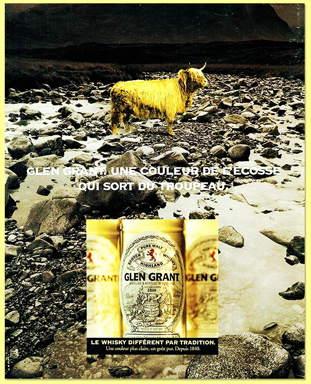 |
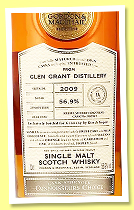
|
Glen Grant 14 yo 2009/2024 (56.9%, Gordon & MacPhail, Connoisseurs Choice, Kirsch Import Germany, refill sherry hogshead, cask #900927, 269 bottles) 
Colour: light gold. Nose: plenty of nougat, acacia honey, Earl Grey tea and brioche dough, followed by a few walnut skins and a touch of pine resin. A playful hint of something slightly lactic, like vanilla custard. With water: tomato leaves, ferns, carrot tops, and baker’s yeast… This baby seems rather untameable. Mouth (neat): good, powerful, slightly sweet, then increasingly bitter and herbal, with cherry stems, thyme infusion, green pepper, and cardamom… It clearly cries out for water, now Glen Grant often swims like a champion. With water: much, much better now, featuring orange pastilles, dried raisins, cloves, and a touch of ras-el-hanout. Finish: rather long, leaning once more towards infusions and teas, but all is well. A slightly more chocolatey aftertaste. Comments: this restless baby is a bit all over the place, which is quite entertaining. With patience and water, you’ll tame it.
SGP:561 - 85 points. |
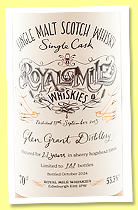
|
Glen Grant 21 yo 2003/2024 (53.3%, Royal Mile Whiskies, sherry hogshead, cask #59894, 181 bottles) 
RMW have had some fab whiskies this year – ooh that Springbank. One wouldn’t expect this GG to be of the same calibre, but you never know. Colour: light gold. Nose: wait, what’s this? We find here that very particular mineral style reminiscent of the ‘pale’ Glen Grants distilled in the 1950s! I swear! Plus, marrow, stearin, cement dust, and paraffin oil… Could someone explain this? With water: mosses, ferns, and fig leaves, even a little tar and clean mud. So deliciously old-school, let’s say Harry Lauder-esque. Almost. Mouth (neat): a touch of ‘quality’ retsina at first, plenty of green pepper and yellow capsicum, pine sap, then a hint of pad Thai and a chalky, almost metallic edge, rounded out with apples and lime. Very curious to see what water will do to it. With water: boom, everything folds into place—lemon, mint, green olives, candied angelica. Excellent. Finish: long and much more compact and cleaner. Juicy Fruit Gum. Comments: what an adventure. Its only flaw is that it’ll demand time. Indeed, every time.
SGP:561 - 88 points. |
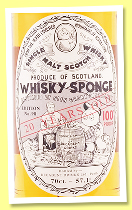
|
Glen Grant 20 yo 2003/2024 ‘100°proof’ (57.1%, Whisky Sponge, Decadent Drinks, #98, 1st fill barrel, 169 bottles) 
The label here reflects the affection – and rightly so – that ex-Mr Sponge holds for old Glen Grant bottlings. Colour: light old. Nose: ah yes, rapeseed and sunflower oils, bruised apples, old copper objects (not necessarily a copper dog), fresh concrete, and half-burnt church candles—spot on. With water: yeasty notes emerge, with hints of toasted bread and bottled lemon juice. Mouth (neat): somewhat fresher and more citrusy than the RMW, though certain aspects feel similar (citrus, sap). Like biting into a scented orange candle sprinkled with pink pepper, or something along those lines. With water: oh, yellow peaches and apricots! That’s unbeatable according to our own dogma. Finish: long, fruity yet elegant, with a certain restraint. I know, that doesn’t mean much. A touch of pine sap lingers in the aftertaste, adding a slight bitterness. Comments: flirting with 90 points. Let’s call it 89.49, though we always round to the nearest whole number.
SGP:651 - 89 points. |
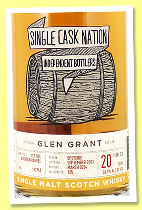
|
Glen Grant 20 yo 2003/2024 (58.9%, Single Cask Nation, 1st fill bourbon barrel, cask #192741, 165 bottles) 
Colour: white wine. Nose: it would seem these 2003s are rather explosive, and here we have an even livelier version, with just a touch of fresh butter alongside green, white, yellow, and red apples in all their forms, including tarte tatin. Lovely rooty touches—celery, radish, beetroot… With water: and here come the chalk and paraffin! Mouth (neat): almost a carbon copy of the Sponge, but greener, almost acidic. Love this, as they sometimes say, it lets you count your vertebrae as it goes down, ensuring everything’s in place. The worst part is we really love it. Great tension! With water: the fruits come bursting out—green melon, white peaches, green bananas, and of course, apples of every kind. Finish: long and taut, but also with a few exotic fruits—passion fruit and lime. Comments: these talented independents really do an excellent job with their selections.
SGP:561 - 88 points. |
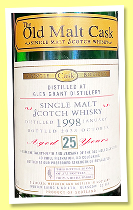
|
Glen Grant 25 yo 1998/2023 (50%, Hunter Laing, 25th Anniversary of the Old Malt Casks, refill barrel) 
These replica-style bottles haven’t been around for very long. In fact, it’s not very kind—do they even realise the effect this distinctive livery has on us every time we see it? It brings to mind Ardbeg 1975 ‘702’ or ‘Brorageddon’; beware of heart palpitations! Colour: pale gold. Nose: oh, vegetable oils, pollens, and ripe apples. It’s hyper-precise and simply perfect—you don’t need anything more. With water: nothing more, and that’s absolutely fine. Perhaps a faint touch of paint. Mouth (neat): simple yet excellent. Ripe apples, ripe pears, a hint of soft paprika, soft honey, and chamomile. With water: perfectly ‘Western’ fruits—orchard fruits, for example greengages, whose near disappearance from our local markets remains a great shame. Finish: beautifully long, with similar notes and just a hint of wax. Comments: a magnificent Glen Grant, ‘normal’ with everything that’s most enjoyable about normality (that’s not very woke, S.).
SGP:551 - 87 points. |
Needless to say, we hadn’t planned on tasting quite so many. But since we’re at it, and as this is the last whisky tasting of 2024, let’s wrap up this little session with one of the ‘fathers’ of modern independent bottling, if you don’t mind… |
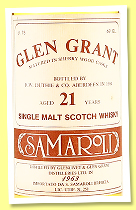
|
Glen Grant 21 yo 1963/1984 (46%, Samaroli, R.W. Duthie, sherry wood, 480 bottles) 
The delightful Silvano Samaroli explained, on the back label, that this Glen Grant was distilled before the distillery expanded from 4 to 6 stills in 1973 and from 6 to 10 stills in 1977. Strangely, it seems they have 8 stills now—perhaps they sold 2 to Macallan (just joking!). In any case, even back then, Samaroli didn’t colour his whiskies with caramel or chill-filter them, which might explain this… Colour: hazy pale gold, almost opaque. Nose: metal polish, luxury shoe polish, plasticine, and wheat beer dominate at first, before being joined by rutabagas, parsnips, and other so-called ‘forgotten’ vegetables. Old apples and lemon zest then brighten things up. A lovely metallic touch typical of old Cadenhead’s, though please note—this was no screw cap like the ‘dumpies’. Mouth: straight into a forest, with mosses, mushrooms, resins, and saps (birch, fir). The ever-present apples then take over in the most beautiful way, accompanied by pollens and floral syrups (mullein). You do sense a tiny bit of fatigue after 40 years in bottle, like an old white wine of fine pedigree, but it never falters. Finish: medium to short, with a sudden burst of small citrus fruits that bring everything back into balance. How amusing! Bergamots dominate the aftertaste. Comments: a charming fragility that reminds us whisky is a living thing (what?). Yet some aspects also recall those magnificent old official bottlings we’ll be tasting in a few weeks, as promised.
SGP:562 - 90 points. |

|
Serge's Non-Awards
Here's a brief rundown of my top picks from the roughly 1,400 whiskies and other spirits I sampled in 2024, continuing our annual tradition. Don't take it too seriously; I find these lists are often more of a routine exercise than anything truly meaningful—unless they're sponsored, then they serve a marketing purpose. But here we go again... |
Favourite recent bottling |
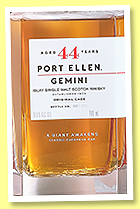
|
|
Port Ellen 44 yo 1978/2023 'Gemini Original Cask' (54.9%, OB, European oak butts, 274 bottles, 2024)
WF 95
Port Ellen, of course, with its brand-new and, shall we say, highly aesthetic distillery. We could just as easily have chosen the recent Brora 1977 ‘Untold Depths’, which we also scored 95/100, but Brora already won in 2023, so... A third and very serious contender for this title is the Glen Grant 1958 'Mr George Legacy Fourth Edition' from Gordon & MacPhail. Admittedly, all these bottles are horrendously expensive—I’m well aware of that—but at least their contents represent the very best Scotland has to offer at the moment. IMHO, as we used to say. |
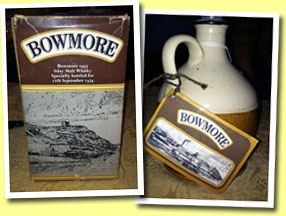
|
|
Bowmore 1955/1974 ‘For 12th September 1974’ (unknown ABV, OB, 100 half jugs)
WF 96
We tasted this marvel once again, this time from a different decanter than those we had previously sampled, all in support of our shared noble cause. Rest assured, we won’t elaborate further—just to add that another Bowmore, the 1969/1978 for Fecchio & Frassa at G.L.58, came very, very close. |
Favourite bang for your buck |
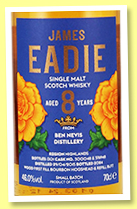
|
|
Ben Nevis 8 yo 2015/2024 (46%, James Eadie, Small Batch, The Rose & Crown, first fill bourbon hogshead, 1,301 bottles, 2024)
WF 88
We could also have chosen Springbank 10 or Ardbeg 10, as usual, which seem to be returning to very affordable price levels (Ardbeg 10 at €45 in supermarkets in France at the end of this year). However, we also wanted to highlight the high quality of these independent releases from James Eadie. This splendid young Ben Nevis is priced at €69—well worth it! Note that we very rarely talk about prices, but when it comes to BFYB, we can hardly avoid it, ha! |
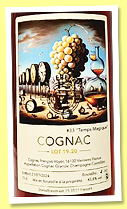
|
|
François Voyer ‘Temps Magique Lot 19.20’ (43.8%, Malternative Belgium, Grande Champagne, 2024)
WF 93
An absolutely incredible cognac from Malternative Belgium, which does a truly remarkable job selecting old cognacs. Even if it does irk us a little to see our dear Belgian friends somewhat diverting these great French spirits (just teasing, of course), it’s a good reminder for us in France to take more interest in what we produce! Several other cognac houses also rank very highly—Vallein Tercinier, JL Pasquet, Famille Cabanne, Tiffon, and others. In fact, we had a Cabanne that scored 94, but it was bottled in 2023. |
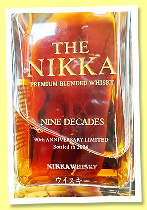
|
|
The Nikka ‘Nine Decades’ (48%, OB, 90th Anniversary Limited, premium blended whisky, 2024)
WF 92
I feel that 2024 has marked the triumphant return of Japanese whiskies, following several years somewhat marred by overpriced NAS malts and so-called Japanese whiskies sourced abroad and merely bottled in the Land of the Rising Sun. We’ve tasted some exceptional Yamazaki and Hakushu, for example—not to mention the intergalactic Chichibus ex-bourbons, Mars, and these impressive new malts like Shizuoka that continue to amaze us. All of this leads us to highlight a… blend—but not just any blend. This Nikka was simply stunning! |
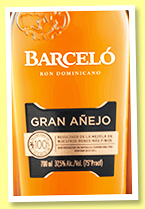
|
|
Barcelo 'Gran Anejo' (37.5%, OB, Dominican Republic, +/-2023)
WF 25
People often make fun of rums boosted with sugar (now labelled as spirit drinks in Europe), but at least those have some flavour (awful, but flavour nonetheless). In contrast, this poor little Barceló, despite being carbon-neutral, felt emptier than a jeroboam of Bollinger after a New Year's Eve party. Another contender is El Ron Prohibido 15 yo 'Gran Reserva' from Mexico, which really ought to remain 'prohibido' (WF 25). Then there are those whiskies sourced from improbable countries and sold at rock-bottom prices in supermarkets, masquerading as Scotch. Yuk. |
Right tomorrow we'll try to publish a complete list of all the one hundred and thirty-three 92 points + we've tasted in 2024, Angus and myself, possibly with comments if Bollinger's Jeroboam allows us, |
| |
December 30, 2024 |
|
  |

|
WF’s Little Duos, today precious old Bunnahabhain plus apéritif |
(Remembering John MacLellan) |
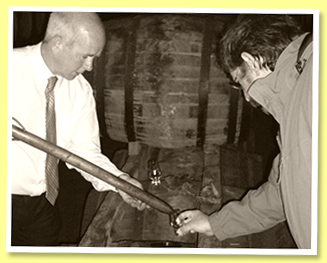 |
We will have plenty more Bunnahabhains at the start of next year, but for now, we wanted to celebrate the end of the year with two very prestigious old bottlings, preceded by an aperitif that shouldn’t be too bad either.
(Warehouse tasting, early 2000s, WF Archive) |
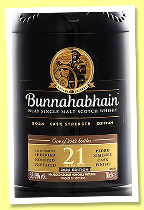
|
Bunnahabhain 21 yo ‘2024 Cask Strength Edition’ (53.6%, OB, oloroso + 21 months Pedro Ximenez cask finish, 2682 bottles) 
What proportion of new Scottish malts are now PX-finished? One rather gets the impression we’re nearing 50%, which must be splendid news for Andalusian coopers (Jerez, Huelva, Montilla, Malaga). That said, it does leave us increasingly reflective about what Scottish distillers truly think of their ‘natural’ products and the casks they employ for new fillings. Nevertheless, there are, of course, some excellent PX finishes, especially when not from first-fill casks. Colour: amber. Nose: it opens with cedarwood, pencil shavings and gum arabic, before shifting towards sultanas, dried figs and even a hint of strawberry jam made with brown sugar. One cannot deny that this is certainly modern, with noticeable fresh oak, but very well executed. With water: chocolate and coffee, with cedarwood still taking the lead. Mouth (neat): drier than the nose suggested, but also far spicier, featuring a mix of cinnamon, pepper, ginger and nutmeg that instantly evokes fresh oak once more. Sultanas and dried figs follow but fail to fully mask the pronounced woodiness. With water: similar remarks. Plenty of liquorice wood, turmeric and cardamom. Finish: very long and still intensely spicy. Red pepper, curry and dark chocolate, with a touch of orange zest in the aftertaste. Comments: decidedly modern and cask-driven, but certainly very well made.
SGP:372 - 85 points. |
The next two should be less 'modern'... |
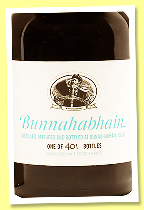
|
Bunnahabhain 35 yo 1966/2002 (46.1%, OB, Feis Ile 2002, sherry, cask #4379, 401 bottles) 
This is the first time we’re formally tasting this old expression, dating back to the days when Islay Festival visitors had access to exclusive old whiskies at very reasonable prices (and not the other way round, ha). Note that our benchmark remains the 1968 ‘Auld Acquaintance’. Colour: mahogany/coffee. Nose: I’m immediately transported to the past, back to warehouse tours with John MacLellan, bung-puller and valinch in hand. What memories! At any rate, this is a rich and weighty sherry on the nose, evoking the impression of nosing a very old ‘V.O.R.S.’, with an explosion of prunes and currants. Pipe tobacco, roasted pecans, triple sec and crème de menthe follow. A magnificent nose, quite direct, with even fewer flaws than a Botticelli. Mouth: drier, focusing more on aged walnuts, unsweetened coffee and very dark chocolate, before moving towards increasingly wonderful notes of bitters of all kinds. It turns slightly drying, but this almost becomes a positive trait in this context. Chestnut honey brings some sweetness back after about a minute. Finish: fairly long, very elegantly dry yet gentle at once. Blackberry and blueberry jam linger, with a peppermint and Christmas cake aftertaste (better use this descriptor while it’s still in season). Comments: I feel this comes very close to the stupendous Auld Acquaintance. I also think it’s time we revisit the latter soon—it’s high time to re-check some of our benchmarks. Brilliant.
SGP:651 - 93 points. |
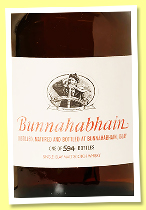
|
Bunnahabhain 35 yo 1965/2001 (53.9%, OB, Feis Ile 2001, sherry, cask #7159, 594 bottles) 
Same comments about the Islay Festival, right. I believe this baby, like the previous one, came from genuine sherry butts rather than casks custom-made and seasoned for the whisky industry. That’s certainly what one could observe in Bunnahabhain’s warehouses at the time, I mean in the very early 2000s. Colour: deep gold—not ‘coffee’ this time. Nose: magnificent, though less dominated by sherry, making it fresher, almost slightly maritime (seaweed, brine), before leaning more towards orange marmalade and cherry liqueur. A faintly earthy touch is quite superb, followed by tobacco and a hint of new leather. Pistachio nougat. With water: almost like an old cognac now, with honey and wonderfully ripe, juicy vineyard peaches. Mouth (neat): the sherry comes through more strongly, as do the spices, making it feel slightly – but beautifully - rustic at this stage despite wonderful citrus and honey notes. Quite a bit of peppermint emerges later. With water: and there it is, tamed and gentle as a lamb, with sultanas, plenty of candied fruits, and a lovely cup of tea with dark chocolate. Finish: fairly long and spicier, with occasional faint herbal touches. Liquorice with mint lingers in the aftertaste. Comments: this splendid dram may have suffered ever so slightly when compared with the utterly supersonic 1966. Fond memories of John MacLellan.
SGP:551 - 92 points. |
| |
December 29, 2024 |
|
  |

|
|
A word of caution
Let me please remind you that my humble assessments of any spirits are done from the point of view of a malt whisky enthusiast who, what's more, is aboslutely not an expert in rum, brandy, tequila, vodka, gin or any other spirits. Thank you – and peace! |

|
Our final rums of 2024 |
A selection of more or less easy-going rums for this very end of the year, actually chosen at random but starting with two or three aperitifs without too much ambition.
Christmas in Martinique is even better than elsewhere! (France-Antilles Martinique)
|
 |
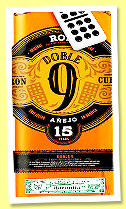
|
Doble 9 15 yo ‘Anejo’ (38%, OB, Cuba, +/-2024) 
An amusing bottle adorned around its neck with a domino featuring a double nine, a nod to the traditional Cuban domino game. I’ve never encountered this fairly new brand in Cuba, but the Cuban government’s authentication label does appear, well, authentic, even if it seems this rum was blended and bottled in the Dominican Republic after having been produced in Cuba. The bottling strength of 38% remains just a tad worrying… Colour: pale gold. Nose: it doesn’t quite feel its supposed 15 years and comes across as extremely light, offering a distinctly Cuban touch (fresh hay, for instance) along with a hint of lime. It’s all rather inoffensive. Mouth: there’s a faint sweetness, though it’s hard to tell if it’s been boosted, resting on a slightly herbal base. Still very light, not unpleasant, with subtle hints of coconut and instant coffee. Finish: very short, with orange liqueur lingering in the aftertaste. Comments: it’s really quite decent, I think.
SGP:330 - 70 points. |
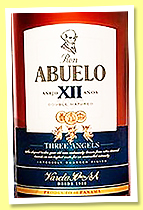
|
Abuelo XII anos ‘Three Angels’ (43%, Panama, +/-2024) 
The Abuelo XII ‘Two Oaks’ was rather average and fairly laden with sugar three years ago (WF 60). This ‘Three Angels’ edition was partially aged under the warehouse roofs, where temperatures are always higher and thus the angels’ share more significant (15% per year, they say, but did the casks actually spend at least a year under the roofs?). The 43% ABV is a good sign. Colour: amber brown. Nose: I quite like this—it’s rather dry, offering notes of coffee, dark chocolate, black tea, burnt wood, roasted chestnuts, and even hints of menthol and liquorice. So far, so good. Mouth: there’s some sugar and molasses, but not excessively so, accompanied by molasses honey and a touch of coffee liqueur. Roasted hazelnuts, dark raisins, and even a faint muscat-like note appear. Finish: long, certainly sweet but without too much excess this time. Comments: it’s worth noting that, under EU rules, a spirit can no longer be labelled as ‘rum’ if it exceeds 20 grams of added sugar per litre. I think this rather nice Abuelo stays within that limit, although the sugar remains noticeable. Miles ahead of the earlier ‘Two Casks’.
SGP:650 – 75 points. |
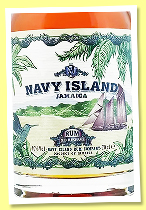
|
Navy Island Jamaica ‘XO Reserve’ (40%, Navy Island Rum Company, Jamaican blend, +/-2024) 
This baby at 40% ABV and without an age statement is rather pricey (€45), but then again, it’s a blend of ‘pot still’ Hampden, Monymusk, and Worthy Park. So, in the end, it’s not that expensive, is it. Colour: light gold. Nose: it reminds me of the early Mezan blends. Surprisingly light but not at all ‘empty’, featuring carbon paper, light brine, and ultra-ripe fruits (those famous pineapples ‘teetering on the edge of the road’ as we say in French), along with a faint touch of wood varnish. It whispers, but what it says is lovely. Mouth: similarly light but not empty—let’s say ‘pastel’. Nice salinity, two or three capers, a bit of tar and salmiak, then a small piece of tarte tatin. Light pepper. Finish: not very long, of course, but acceptable. Bits of pineapple in brine? Do those exist? Comments: perfect for introducing your guests to Jamaican rums without immediately forcing them to gulp down Hampden <DOK at 67.5% ABV. Very nice—do they also make a 100-proof version?
SGP:642 – 85 points. |
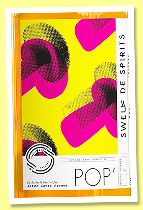
|
Bielle 2015/2024 (54.9%, Swell de Spirits x Inter Caves, Pop' series, Marie-Galante) 
Bielle is Bielle (well, you’ve outdone yourself, S.) This one spent 7 years on Marie-Galante before sailing to France in 2022 aboard the two-masted schooner ‘Avontuur’. Look her up on Google—it’s a fine ship. Colour: bright straw. Nose: it’s unmistakably Bielle, with those aniseed notes mingling with fresh cane and putty. Magnificently fresh—perhaps the Atlantic crossing on a sailing ship further amplified that impression. With water: even prettier, with hints of old fuel oil, eucalyptus, more anise, and mint. Mouth (neat): that medicinal edge also evokes certain artisanal cachaças (did the schooner take a detour via Brazil?), along with lemon, fresh cane, pink grapefruit, and a touch of fennel. A rum like no other. With water: citron liqueur, candied cherries, and angelica. Finish: not especially long but superbly refreshing. Impressions of putty and anise return in the aftertaste, followed by lemon and pepper. Comments: utterly charming, this Bielle. Plus, pouring it to friends allows you to recount the story of the schooner, its wind turbines, solar panels, and all that. An awesome beast.
SGP:562 – 90 points. |
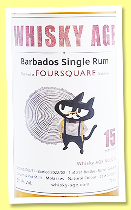
|
Foursquare 15 yo 2006/2022 (59.1%, Whisky AGE, barrel, #15, 231 bottles) 
It’s hard to imagine anything going wrong here, though one might still dream of a pure pot still FS. That said, the label clearly specifies this is the usual self-blend of column and pot still. Colour: straw. Nose: I’m not entirely sure how many different combinations they experiment with in terms of percentages of the two styles, but here the pot still seems to take the lead, leaving the lighter column rum in the background. I’m getting chalk, soot, even a touch of saltpetre, grape seed oil, pistachio, and praline… In the end, it’s still fairly elegant, even delicate. With water: hints of fresh cake, fougasse, scones, orange cake, and ginger cookies… Mouth (neat): that famous orange marmalade with cane syrup and green and pink peppercorns. No complaints here. With water: not much evolution, but that’s perfectly fine. More fresh cane juice and perhaps even a small glass of umeshu. Finish: medium length, featuring pu-ehr tea and just a touch of turmeric. Vanilla and a bit of coconut linger in the aftertaste, along with one wee dried fig. Comments: in the end, this is quite a gentle Foursquare, but/and it’s excellent.
SGP:551 – 88 points. |
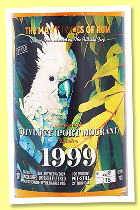
|
Uitvlugt Port Mourant 1999/2024 (47.1%, The Whisky Jury, Guyana, refill barrel, cask #88, 173 bottles) 
It’s worth remembering that 1999 was the final year for Uitvlugt before everything was transferred to Diamond, including the very old Port Mourant still, which had first been at Albion before being moved to Uitvlugt. Let’s say it again, please repeat—the still from… Colour: gold. Nose: monstrously beautiful, as the relatively low bottling strength already hinted. Extraordinary notes of fresh rubber, liquorice, overripe mangoes, oysters, olives, Bakelite, engine oil, and oil paint in every imaginable colour (really?), plus linoleum… Mouth: this is absolutely maddening. A perfect combination of mango, tar, liquorice, and seaweed. And countless other nuances, but we don’t have all day… Finish: long, with salinity becoming even more pronounced. The mango and other elements echo in the aftertaste, which is just slightly astringent overall. Fairly strong pepper. Comments: very, very maddening.
SGP:463 – 91 points. |
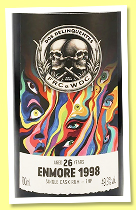
|
Enmore 26 yo 1998/2024 ‘EHP’ (49.3%, WFRC & WDC, Dos Deliquentes, 204 bottles) 
Ex-wooden 2-column Coffey still (still a mystery to this humble whisky geek) with ageing in bourbon, armagnac, and refill rum casks—the whole process remains even more mysterious to me. Yes, EHP means Enmore. I suppose we’d better focus on the liquid if you don’t mind… Colour: gold. Nose: the softest of the Guyanese bunch, featuring plenty of yellow flowers and all kinds of cakes, notably coconut balls and vanilla sponge, followed by praline and English tea ‘with a splash of milk’. Really very civilised. Lovely little earthy touches emerge next. Mouth: an unusual profile combining coconut and vanilla sweetness with hints of glue and solvent, plus a yeasty background. Finish: medium length, turning alternately acetic and more focused on cane and little fruity sweets. Comments: very hard to follow the Port Mourant—I probably should have tasted this first, but I followed the order of bottling strengths. Still excellent, though I think this one is for über-geeks and Demerara rum scholars. In short, being softer doesn’t mean it should be handed to just anyone. Very hard to score, as my rum knowledge stops here.
SGP:641 – 85 points (to be taken with a large pinch of salt). |
Let’s liven things up a bit… |
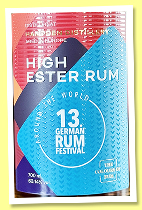
|
Hampden 2023/2024 (63.14%, The Colours of Rum for 13. German Rum Festival, Jamaica) 
Some DOK aged in ex-PX, oloroso, and bourbon. What a funny joke—who’s going to notice the various casks in a DOK at 63%? Sorry, 63.14%. DOK, as a reminder, means 1,500 to 1,700 gr ester/HLPA. And this one’s got plenty of that ‘A’, so plenty of esters. Right then, let’s say our prayers and brace ourselves… Colour: gold. Nose: let’s be honest—our olfactory bulb, which processes scent signals from receptor neurons in our nasal cavity, quickly filters out anything deemed ‘excessive’. That’s why we sometimes find Octomore ‘not so peaty’ or DOK ‘not so acetic/tarry’. In short, it’s just a stunning Hampden. With water: I feel like you could drown this in Vittel (our official water—we’re still unpaid, mind you) and it wouldn’t change a thing. Maybe hints of burning tyres or a failed burnout by a novice Harley rider. Mouth (neat): superb sharpness, as if eating unripe salted olives in absurd quantities while sipping Tesla brake fluid. Well, I imagine. With water: here comes the lemon, green pepper, salted liquorice, and so on. Finish: very long, though ultimately slightly dominated by rubber. Comments: absolutely insane.
SGP:475 – 88 points. |
Come on, one last one that 'might' stand up to this utterly infernal Germanic DOK… |
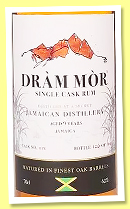
|
Secret Jamaican Distillery 9 yo 2012/2022 (62%, Dràm Mor, bourbon barrel, cask #072, 198 bottles) 
In general, these secret Jamaicans are Worthy Park, though of course there’s no proof. Colour: full gold. Nose: ultra-ripe exotic fruits, hints of ammonia and acetone, artichokes, olives, pipe tobacco, crushed gravel, and slate. Overall, the structure feels finer and fruitier than some of the other famous Jamaicans, which lean a bit more towards ‘doom metal’ than WP’s classic hard rock (what?). Okay, not Appleton. With water: oh, scallops cooked in Noilly with little Chinese mushrooms. And there you have it—I’ve made myself hungry. Mouth (neat): simply perfect. Equal parts citrus juice and seawater. Excellent, precise, very WP. With water: intensely maritime and lemony before tar and highly concentrated molasses take over. Finish: almost spicy, thick, and peppery. Quite fun. Unexpected notes of flambéed and salted bananas appear in the aftertaste. Comments: a lively little Jamaican with plenty to say—at the very least.
SGP:563 – 88 points. |
 Check the index of all rums we've tasted so far Check the index of all rums we've tasted so far
|
| |
December 27, 2024 |
|
  |

|
Four young indie Tamnavulin |
During the festive season, we traditionally enjoy well-known names, but we also make a point of including lesser-known distilleries—remember, one of our mottos is "little names, big whiskies", although we can’t claim to have absolute proof of that, mind you. Today, we’ll be tasting Tamnavulin from Speyside, which, unfortunately, we don’t sample very often. Over all these years, we’ve formally tasted only about thirty of them—just to give you an idea. It’s true that it has been rather quiet, albeit intermittently, and was only relaunched quite recently, in 2007.
We’ll start with some ex-bourbon, and then, I believe, we’ll have three ex-sherry casks. |
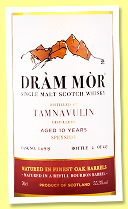
|
Tamnavulin 10 yo 2013/2024 (55.3%, Dràm Mor, refill bourbon, cask #110915, 225 bottles) 
Colour: white wine. Nose: absolutely perfect, damp chalk, grist, green apples and sour cherries, then lemon and a hint of candle wax. With water: that fresh new jumper vibe, plus paraffin and black soap. Mouth (neat): the purity of a fresh and invigorating young malt, no frills, slightly rustic but crammed full of fruit peels and lime, the whole becoming increasingly herbal and taut. No mercy given, and none required. With water: small white and yellow fruits awaken, white currants, green pear, and pepper (green and grey) … Finish: long, herbal, almost sharp. Loads of pepper. Comments: fairly brutal, but one gladly yields to its charms. What one might call a natural wee malt, perfect for your hipflask (the one with the skull and the Indian Motorcycles logo).
SGP:361 - 84 points. |
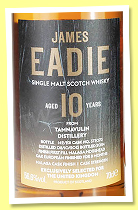
|
Tamnavulin 10 yo 2013/2024 (56.6%, James Eadie, UK exclusive, 1st fill Malaga hogshead, cask #373073) 
Malaga! One dreams of PX seco, the great wine of Malaga in our view, rather than the thicker and sweeter concoctions (though some of those are excellent too). Colour: gold. Nose: in any case, this was a circumspect finishing, and we’re not buried under three tonnes of raisins. Quite the opposite, as apples take the lead once more, along with chalk, limestone, cake, and a few fresh walnuts lurking in the background. With water: the chalk, grist, and fresh wool return. This PX was very well-raised. Mouth (neat): there’s a touch of walnut cake, but it’s the spices that take centre stage, with green pepper and orange peel. Cinnamon mints. With water: more sherriness (or rather, malaganess) emerges, with raisins and bay leaves joining the walnuts. Finish: long, now slightly bitter. Comments: for your second hipflask (the one with the Confederate flag and the Harley Davidson logo).
SGP:361 - 84 points. |
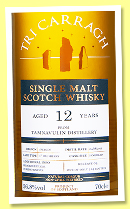
|
Tamnavulin 12 yo 2011/2023 (56.8%, Tri Carragh, 1st Fill PX Sherry Hogshead, 314 bottles) 
Colour: white wine. Very pale for a 1st fill PX. Nose: perhaps this was seco? Here we lean more towards paraffin, plasticine, fresh rubber, and even sulphur (in powder form, not burnt). I quite like this ‘industrial’ style. With water: we drift back towards the style of the previous dram, with fresh walnuts emerging along with citrus peels. Mouth (neat): odd, even deviant, with loads of lemon and, once again, green pepper. A prickly, almost fizzy edge (ginger tonic) and a touch of gin, even with a soapy hint. Well, I rather like it—it’s very unusual. With water: adorable ginger tonic with lemon. I won’t name the brand, as I never did receive the keys to that Dubai penthouse I was promised. Finish: long, taut like a fine cool-climate Chardonnay. The aftertaste turns more herbal and bitter (ouch, a point off there). Comments: it really feels like PX seco, bone-dry and sharp as a whip. I rather love it.
SGP:361 - 86 points. |
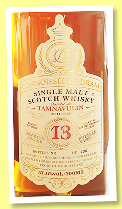
|
Tamnavulin 13 yo 2010/2023 (57.6%, Connoisseurs Dram, DH Global Wine Ltd, 1st fill oloroso, cask #800768, 400 bottles) 
Colour: deep gold. Nose: well then, this is the softer, more civilised ex-oloroso version, seemingly the most cake-like, with fresh kougelhopf, sponge cake, and even rum baba. In the background, oranges (marmalade and liqueur) keep watch. Lovely nose. Did I mention blueberry muffins? With water: tobacco, coffee, and walnuts, all typical of oloroso. Mouth (neat): a much more classic sherry profile, with bitter oranges on top and plenty of pepper and nutmeg. It’s powerful. With water: very good, despite a touch of saponification that makes you wait 10 minutes (as soapy notes appear and then fade) … 10 minutes… and there we have it, a splendid oloroso loaded with walnuts, mustard, pepper, tobacco, and rather dark chocolate. Finish: long and even more peppery and bitter. But the oranges keep watch, as they always do. Comments: an excellent success, though once again, it’s more of a young malt for the hipflask than for your Riedel Vinum glass (the one designed upside down, with the rims turned outward—what a strange idea!).
SGP:361 - 87 points. |
Note that the four summary aromatic profiles (SGP) were identical today. |
| |
December 26, 2024 |
|
  |

|
WF’s Little Duos, today top indie Brackla |
I know, we tasted Brackla not long ago, but many indies are clean and not too smothered by some improbable wine, like the, er, well, you know which ones I mean. When you apply finishings across your entire range, it’s still extremely worrying, in my opinion. Anyway, moving on since, indeed, there are excellent young Brackla among the Indies at the moment. |
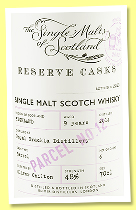
|
Royal Brackla 9 yo 2014/2023 (48%, The Single Malts of Scotland, Reserve Casks, Parcel No.12) 
Colour: very pale white wine. Nose: little to no cask influence, an abundance of citrus fruits, freshly picked apples and pears, hints of liquorice and gentian, then raw cake batter, IPA-style beer, and honeysuckle reminiscent of a Sauvignon Blanc… Yes, it’s almost a Sauvignon Blanc. Impeccable nose, fresh, honest, and straightforward. Mouth: another dangerously drinkable malt that ought to carry a warning label. A superb medley of peppermint, lime, banana cake, and a splash of Jamaican rum (actually just a few drops). The first person to say ‘mojito’ will be reported to the Drinks Police. Finish: long, very fruity yet highly refreshing, with that persistent mojito vibe (hoist with my own petard) before bergamots step in to restore order. Unstoppable. Comments: perfectly chiselled, a very serious contender for December’s Bang-For-Your-Buck bottle.
SGP:651 - 88 points. |
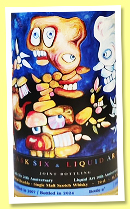
|
Royal Brackla 2007/2024 (51.7%, Cask Six & Liquid Art, 161 bottles) 
At least we can be fairly certain the label—perhaps slightly unsettling—was designed neither with the help of ChatGPT nor Elon Musk’s Grok. One can imagine the brief to the designer: ‘1. down a bottle, 2. do a label’. Colour: pale white wine. Nose: I adore these notes of… well… let’s say olive oil and flat-leaf parsley financier, followed by fully ripe orchard fruits. With water: all the building blocks of whisky emerge—malted barley flour, yeasts, even water itself. And plenty of apples. Mouth (neat): yet another palate that proves it’s a sin to mask such a lovely distillate, even if this one is less emphatically fruity than the 2014. Hints of cherry stems, touches of blackcurrant, and a suggestion of tomato leaves. I suspect water will bring order to these molecules. With water: absolutely, water is essential, revealing a delightful combination of liquorice wood, pears, apples, and white peaches. The tomato leaves? Gone, gone, gone, honey. Finish: medium length, with a return of the grist. Comments: the 2014 was immediate, while this one demands more effort on your part.
SGP:561 - 87 points. |
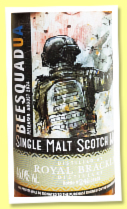
|
Royal Brackla 2015/2024 ‘BeeSquadUA’ (46%, WhiskyUA Kyiv, 1st fill sherry, cask #304266, 358 bottles) 
This very bottling promotes the use and funding of drones for the Ukrainian Army. Drones are inexpensive, can combat weapons worth millions of dollars, and often replace human soldiers, thus saving countless lives in a conflict as terrifying as the one ongoing in Ukraine for nearly three years. Colour: deep gold. Nose: a beautiful malt–sherry fusion, extremely well-balanced, without the slightest sense of layering or artificiality. Notes of squash, carrots, fresh walnuts, celery, apples, tangerines, beeswax, and marzipan… It’s really very pretty. Mouth: the sherry’s nutty character takes over now, along with tea, herbal infusions, chocolate, and coffee, a touch of mustard, leafy tones, a hint of seawater, even dried seaweed, perhaps a splash of Worcester sauce, and a bit of sesame paste… Finish: fairly long, with no marked changes. An extremely fine dry sherry style. Comments: Peace!
SGP:451 - 88 points. |
To purchase a bottle or a pallet of this very fine Brackla and thus help towards achieving a just peace in Ukraine—rather than contributing to the funding of a new jet or Lamborghini SUV (well, perhaps more likely a Range Rover in the current climate) for the CEO of some multinational drinks konzern visit the WhiskyUA website. They have already raised over €110K. |
| |
December 25, 2024 |
|
  |

|
Merry Christmas!
We're Going to Eleven - plus Two - with Port Ellen (1969-1983) |
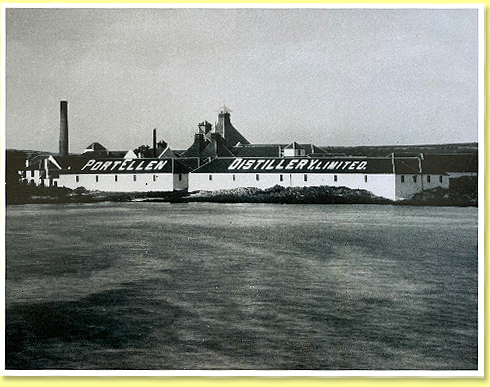
|
| Port Ellen before WWII (Diageo) |
 |
| Port Ellen at night in March 2024 (special event - WF Archive) |
Once again, my apologies for this headline, ha. In any case, 2024 will have been the year of the restart for the famous Islay distillery, following a reconstruction that was decidedly freer than that of Brora, which was rebuilt almost identically. We were fortunate enough to witness Port Ellen’s first distillations this past March, under absolutely incredible early spring sunshine, with a light that only Scotland can offer. |
| But let’s not digress—today, as we face a wait of ten to twelve years before tasting the mature new Port Ellen (although we wouldn’t rule out wandering through the warehouses in the meantime), we’re once again paying tribute to Port Ellen as it was between 1967 and 1983, its final period of activity before a long, forty-year silence. It’s always striking to recall that Port Ellen, in its most recent incarnation before closure, had only “spoken” for sixteen years in total—borrowing a phrase from the Ileachs themselves. Prior to that, it had remained closed from 1929 to 1966! |
| Today, we’re going to sample Port Ellens from various periods, spanning the late 1960s to the spring of 1983. We’ve only ever tasted the 1967 or 1968 once—through the famous 12-year-old expression offered to guests during Queen Elizabeth’s visit to the island in 1980. We know of no others, as the first vintage of Port Ellen to be widely released by merchants was 1969—and that’s precisely where we’ll begin this little tasting session. |
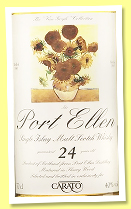
|
Port Ellen 24 yo 1969/1993 (40%, Gordon & MacPhail for Sestante for Carato, The Van Gogh Collection, sherry wood) 
Gordon & MacPhail appear to be among the only independent bottlers to have acquired ‘new filling’ from Port Ellen as early as 1969. These years coincided with the boom in rather smoky blends across the globe, notably Johnnie Walker, which likely prompted the DCL group to boost production on Islay, thus reviving Port Ellen. Colour: gold. Nose: we have often wondered why malts from that era seemed to handle bottling strengths as low as 40% ABV so well, whereas many contemporary malts tend to falter slightly at such levels. As you may have guessed, this 1969 is remarkably fresh yet impressively composed on the nose, though we know the year was magical at Port Ellen. Tiger balm, oysters, tar liqueur, smoked fish, eucalyptus, thyme tea, menthol, plus hints of an ‘old factory’ and ‘ancient library’. In short, old paper, used oils, iron, aged leather, and antique waxes… An astounding nose. Mouth: sublime, profoundly Port-Ellennian, with an astonishingly ashy and tarry power followed by bitter almonds and a growing presence of seawater. The salinity is incredible, almost inexplicable at this strength. In the background, touches of squid ink, oyster sauce, and carbon dust emerge. Finish: it is rare for a whisky this drying to remain so marvellous. A sense of sucking on coal. Waves of seawater return through the retro-olfaction. Comments: it is always a bit tricky to start a tasting with such splendour, as it may put some other malts at a disadvantage. On the other hand, it is generally better to begin with lighter and more fragile strengths. Supposedly. I must add that these whiskies do require a little focus—even at such degrees and despite the distillate’s grandeur, they might just slip by unnoticed.
SGP:467 - 94 points (with a slight touch of sentiment, I freely admit). |
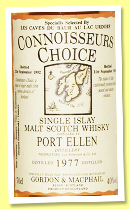
|
Port Ellen 1977/1992 (40%, Gordon & MacPhail, Connoisseurs Choice) 
This features the typical ‘old map label’ of that era, which followed the ‘brown banner label’ and, before that, a few ‘old black labels’. It was later replaced by the ‘new map label’ in the late 1990s, along with cork stoppers instead of the screw caps, which were criticised at the time but are now somewhat missed here and there. Friends are never satisfied. Colour: pale gold. Nose: if I may say so, this is not in the same league as the fantastic 1969, showing overripe apples, dried seaweed, slight cardboard-like and oily touches, dried mint leaves, and a faint hint of hay. The peat, slightly medicinal, is more subdued, though one must recall that the newly rebuilt Caol Ila had just resumed large-scale production of peated whisky after being demolished in 1972 and reconstructed. Still, this remains a very lovely Port Ellen, especially once notes of lime and smoked salmon emerge. Mouth: far smokier and even more bitter than the nose suggests, offering cold mint tea, black pepper, old paper, and a trace of bitter caramel. It tends to fall off somewhat mid-palate, almost certainly due to the lower strength. Finish: medium length, with a metallic impression (silver spoon) and peppered, salted apples. There is also a slight hint of green coffee. Comments: a very fine old Port Ellen, albeit less self-assured, more fragile, and slightly disjointed. I would also add that these ‘G&M CC’ releases at 40% ABV suffered somewhat from comparison with their cask-strength counterparts, especially the superb ‘CASK’ series.
SGP:566 - 88 points. |
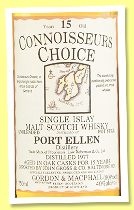
|
Port Ellen 15 yo 1977/1993 (40%, Gordon & MacPhail, Connoisseurs Choice, John Gross & Co. Baltimore) 
Never shying away from any sacrifice, here is a version of the same whisky, or a very similar batch, bottled for the United States. Did you know, by the way, that Low Robertson, owners of Port Ellen, were one of the first—if not the first—Scottish houses to export their malts to the United States? Their most famous blend, packed with Port Ellen malt of course, was called ‘Old Guns’. Colour: yellow gold. Nose: initially different, perhaps a touch waxier and cardboard-like, also slightly more pastry-like (pecan tart), yet the two 1977s eventually converge once all the molecules settle. A very charming, old-style charcoal nose. Mouth: we are very close right from the start, with this highly saline profile and smoked fish. It may tend to fade slightly later on, as shellfish, citrus, and tars briefly take over. Finish: medium length, slightly cardboardy and, once again, faintly metallic. A hint of green pear. The aftertaste returns to more typical ‘Port Ellen’ notes, featuring tar, seawater, and fish oil. Comments: we are still not in the realm of burnt rubber and cask-strength solvents, but it is true that we remain within the so-called lighter bottlings.
SGP:566 - 88 points. |
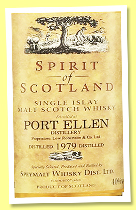
|
Port Ellen 1979 (40%, Spirit of Scotland, Speymalt - Gordon & MacPhail +/-1994) 
Like Jas. Gordon, Spirit of Scotland was a brand used by Gordon & MacPhail in certain markets where differentiating from the main label was likely driven by purely commercial reasons. In any case, we have never noticed any significant difference in terms of quality. Colour: pale gold. Nose: a more direct style, perhaps narrower but also more compact and cohesive, with increased notes of lemon, chalk, and iodine, as well as a distinctly more medicinal character, featuring bandages and mercurochrome… It is quite magnificent, and one cannot help but think of the neighbouring distillery just to the east. And no, we are not yet speaking of the new Portintruan distillery - yet. In any case, there is superb tension in this nose. Mouth: as with the 1969, the low strength is hardly noticeable, entirely offset by a nervy distillate that even hints at manzanilla, with pronounced chalky, saline, and fresh walnut tones. It remains very clean, despite a wave of ashes and burnt matter arriving in force. Finish: almost long, slightly vinegary and distinctly lemony, fiercely tarry, saline, and still medicinal. Plenty of green pepper, ashes, and brine linger in the aftertaste. Comments: we have friends who enjoy these Port Ellens as mizuwari, and I can confirm they handle this treatment beautifully. I mean the malts, of course.
SGP:467 - 91 points. |
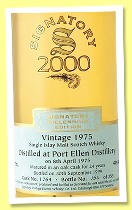
|
Port Ellen 24 yo 1975/1999 (43%, Signatory Vintage, Millennium Edition, cask #1764, 355 bottles) 
For the record, we adored these metal tubes but alas! they were a little ill-prepared for the rise of online shopping and often suffered all sorts of misfortunes during transit. Colour: pale gold. Nose: a more restrained Port Ellen, almost whispering, with wet newspapers, ink, small oysters, and seaweed at low tide, followed by a petrol-like Riesling character reminiscent of Ribeauvillé. The peat never intrudes, and there are even hints of yellow melon. Mouth: the impact of just three extra degrees on the palate is astonishing, as we observe time and again. All the dials seem to be turned up now, especially those of ashes, pepper, lemon zest, and cider apple… Yet everything remains sleek and precise, indeed ultra-compact. Finish: rather long, peppery, and herbaceous, this time with a slightly rustic touch. Ashes and a hint of barley syrup linger in the aftertaste, followed by the impression of having just swallowed a small oyster. Comments: one of those bottles that allowed us to celebrate the arrival of the third millennium in style. I must admit the cask-strength versions from Signatory Vintage had greater breadth, but some of them could send you ad patres without warning if you weren’t careful.
SGP:566 - 89 points. |
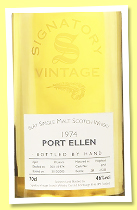
|
Port Ellen 30 yo 1974/2005 (46%, Signatory Vintage, Decanter Limited Edition, hogshead, cask #6757, 235 bottles) 
According to the label, this expression was bottled by hand. From my modest experience, peat at around thirty years of age can begin to break down fractally into myriad small aromas, often circling around fruits, especially tropical ones. I would add that the mid-2000s marked the start of speculative collecting among enthusiasts, driven by the boom in websites. The result was that far more bottles were purchased, yet far fewer were opened and consumed, proportionally. Quite a few of these bottles now appear on auction sites. Colour: chardonnay. Nose: it is perfect, compact, focused, yet expressive, with brine, nuts, the usual tar, tiger balm, citron, and shellfish—mainly winkles and whelks. Not much more to add, it is simple and it is perfect. Mouth: superb tension, featuring grapefruit and green pepper. Nothing much else apart from tar and oysters, but that is more than enough, allowing this old Port Ellen to retain a very clear profile, contrary to what I may have expected. Finish: long, rather oily, with smoked salmon, lemon, dill, and—believe it or not—horseradish and salt. A faint resinous touch lingers in the signature. Comments: I have long been searching for a word to replace ‘precise’ but without success. If you have any suggestions, many thanks. In any case, a truly grand Port Ellen.
SGP:567 - 92 points. |
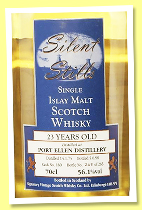
|
Port Ellen 23 yo 1975/1998 (56.1%, Signatory Vintage, Silent Stills, cask #160, 285 bottles) 
We adored this collection, which always included a 5cl miniature and a piece of the cask (supposedly). Legend has it that some of the miniatures fetched higher prices at auction than their corresponding full-sized bottles. Several Port Ellen vintages were part of the series, though this particular release seems especially rare. Colour: pale gold. Nose: stunningly beautiful, pure, and compact without water, showing polish, lemon zest, marzipan, fuel oil, and that distinctive ‘new tyre’ note typical of some Port Ellens. It reminds me of the official ‘Rare Malts’ released around the same time. With water: it fractures beautifully outward from the polish, moving into brass cleaner, Barbour grease, ski wax, paraffin, old paint pots and varnishes, and rust-proofing products… before the fuel oil and rubber snap back into focus. Mouth: tremendous precision. Citrus, peppers, polishes, propolis, and ashes—almost abstract in its clarity. With water: this time it remains compact and concentrated, leaning even more towards lemon and white pepper. Finish: very long, highly taut, fresher and more saline, with slightly less emphasis on anything hydrocarbons. I think that works perfectly here. Comments: there is a touch of raw power in this Port Ellen, but perhaps that’s exactly what we sometimes seek—to be dominated by such a whisky. Well, let’s debate…
SGP:567 - 93 points. |
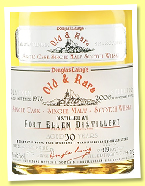
|
Port Ellen 30 yo 1978/2008 (54.2%, Douglas Laing, Platinum Old & Rare, 423 bottles) 
An expression that already feels like it hails from the tail end of the golden age of independent Port Ellens, which were beginning to grow a little scarcer—or so it seemed to me. I’ve never been able to confirm whether the owners, Diageo, had started implementing a policy of buying back casks from brokers and independents, but it would certainly have made sense. Colour: pale gold. Nose: what can I say, except that this is a softer, rounder Port Ellen, leaning more towards oils—particularly toasted sesame oil—then candle wax, wakame, mild soy sauce (for dim sum), and white asparagus. In short, it has begun to show highly tertiary characteristics, which is, of course, magnificent. With water: a blend of tar and seawater takes centre stage. Mouth: an immediate spicy and jammy side, reminiscent of salted and peppered fig jam. Grapefruit, lemon, and yuzu follow closely, then oysters with Tabasco and a fair amount of liquorice and turmeric. It’s rather feisty, once again. With water: perfect, with marzipan, olive and sesame oils, then the expected notes of salt, tar, and ashes make their return. Finish: very, very salty—you almost feel like you’ve swallowed a mouthful of seawater right in the middle of the Mediterranean. Or perhaps in Port Ellen’s marina. Comments: quite sublime, even if the Silent Stills may have slightly overshadowed it.
SGP:566 - 91 points. |
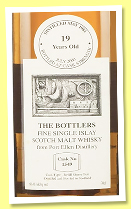
|
Port Ellen 1981/2000 (60.4%, The Bottlers, refill sherry butt, cask #1549) 
We may well be about to close one of the highest-scoring tastings I’ve conducted in at least twenty years. The Bottlers, while they were still active, firmly held the top spot on our lists of bottlers—both independent and official. Since then, we’ve stopped maintaining such controversial rankings. Colour: gold. Nose: we are firmly in Rare Malts territory here, with that raw edge, hints of detergent and solvent, fresh tar, flint, and basalt, followed by lemon zest and fresh shellfish—razor clams, cockles, clams… One inevitably thinks of the finest white Graves. We must bow in respect, you see. With water: unexpectedly, it folds back onto its foundations—preserved lemon, seaweed, and coal tar. Quite amusing. Mouth: these 15XX casks are simply unstoppable—brutal, ultra-taut, superbly structured, downright fiery if you dare take a sip undiluted. The Scottish equivalent of bird’s-eye chilli, in short. In the background, an oddly fleeting hint of strawberry cream appears, though one sometimes catches that note drifting past the maltings—have you ever noticed? With water: all in on seawater, olive oil, lime, and polish. Finish: very long, with a massive arrival of ashes doused in lemon juice. Comments: no room for improvisation here—this is engineered to the millimetre. I would say this kind of profile no longer exists in 2024, whether in terms of distillate or its admirably restrained cask influence.
SGP:567 - 93 points. |
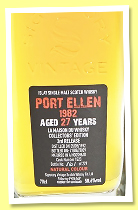
|
Port Ellen 27 yo 1982/2009 (58.6%, Signatory Vintage, La Maison du Whisky Collector’s Edition, hogshead, cask #1523, 229 bottles) 
A bottle that impressed me greatly upon release, with the black label adding even more ‘drama’, as the younger generation might say. Naturally, I secured a bottle, but it’s been at least ten years since the last drop vanished—apologies for the excessively ‘inside’ remark. Colour: gold. Nose: I rediscover that slightly unusual floral and metallic edge, exotic fruits hovering between banana and mango, old furniture wax, a distinctly ‘1969’ character, a few nods to its close neighbours on the shore and to Bowmore, high-grade engine oil, pollen, and dusty old books. With water: very pretty, now showing pistachios and macadamia nuts, rowanberry eau-de-vie, and those familiar old paint pots in the basement. Mouth: massive and dominant, once again. Melon rind, tar, eucalyptus, wax, seawater, a hint of lanolin, and above all a beautifully orchestrated medley of citrus fruits. With water: flawless, as the water elevates both the citrus and wax to centre stage. Once again, there’s that rowanberry eau-de-vie, which one might enjoy in Alsace over pistachio ice cream, in varying proportions (see what I mean). Finish: long and complex, slightly rustic and herbaceous, with ferns and moss. The peat resurfaces in the retro-olfaction. Comments: we used to say that a complex, evolving malt was a ‘whisky-film’ as opposed to a ‘whisky-photo’. I wonder if we might be dealing with a ‘whisky-series’ here.
SGP:457 - 93 points. |
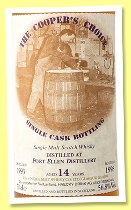
|
Port Ellen 14 yo 1983/1998 (56.8%, The Cooper’s Choice, The Vintage Malt Whisky Co., sherry) 
An amusing release, mistakenly vintage-dated as “1993” instead of 1983. In any case, we’ve already tasted many wonders from The Cooper’s Choice and believe the final months of what must now be called the ‘Old Port Ellen’ rank among its very best—much like Brora’s final days. But let’s verify… Colour: gold. Nose: magnificent, as expected, leaning towards pine and fir ashes, turpentine essence, hints of radish and mustard, and a faintly smoky old fireplace. There’s also that manzanilla-like note we’ve detected in others. It’s pure and precise, and opportunities to taste young Port Ellen of this calibre are now few and far between. With water: the sea, shellfish, fish, fresh paint, tarred ropes, old blue plastic crates, Muscadet, and seaweed… Mouth: a direct hit to the chin—pepper, mustard, maximum peat, and three tonnes of tar. Let’s try to regain composure… With water: small herbs emerge—dill, fennel, damp earth, parsley, and watercress. It’s fresh, it’s perfect, and it balances out the slightly massive nature of the distillate. Finish: long and jammier, with slightly salted orange marmalade. All sorts of ashes jostle in at the very end. Comments: it’s always moving to taste these final vintages, but now that Port Ellen has been rebuilt and is speaking again (as is Brora!), things are starting to feel more celebratory once more. In any case, what a beast this young Cooper’s Choice is.
SGP:467 - 93 points. |
|
Angus's Corner
From our correspondent and
skilled taster Angus MacRaild in Scotland
Here is my modest contribution to the Port Ellen-flavoured Whiskyfun Christmas celebrations. All the best from WF Scotland's West Highland office by Loch Fyne, have a braw holiday, one and all!
|
 |
|
|
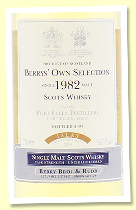 |
Port Ellen 1982/2007 (46%, Berry Brothers & Rudd, cask #2850) 
Colour: white wine. Nose: it could be the bottling strength, but it feels like a much gentler side of Port Ellen, with many crushed seashells, coal smoke, some of that familiar 'grubby' character (think fisherman's wellies, creel nets etc) and then some crushed nettles and pink grapefruit which bring a feeling of fruitiness. Very attractive profile that somehow manages to feel both simple and complex - I know, makes no sense. Mouth: nicely punchy arrival, much more focussed now, with a big, assertive coastal character. Many wet rocks, mineral salts, seawater, lemon juice on shucked oysters and an impression of carbolic acidity - like taking a big mouthful of fermented peaty wash during a distillery tour, like we used to offer at Ardbeg during more innocent times. I also find some lovely elements such as heather flower and sandalwood, which once again nod towards a lighter side of PE. Finish: medium length, crisply smoky, still persistently coastal and with some classic medicinal characters such as iodine and TCP in the aftertaste. Comments: an easy Port Ellen for your tumbler at Christmas, in theory anyway, sadly my sample is finito! Looks like Serge wasn't 'too' impressed with this one back in 2010 (WF85), I think it's a bit better than that, but perhaps that's what 15 (what?!?!) years in the bottle will do...
SGP: 455 - 88 points. |
|
|
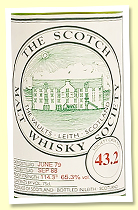 |
Port Ellen 1979/1988 (65.3%, Scotch Malt Whisky Society #43.2) 
These early SMWS bottlings from the big name distilleries are now hyper-scare. Thankfully, our contacts in the world of wealthy highland fish and chip merchants remain deep and robust... Colour: bright straw. Nose: leaps out of the glass like a horny salmon up a well-laddered waterfall! Which is to say: pure petrol - even glycerine - seawater, mustard powder, camphor and many assorted 'beach things', foam, sand, barnacles, driftwood and shellfish etc. Beautifully coastal but at the same time giving the impression of immense thickness, body and texture. There's also some weighty peat smoke in there, which has the slight impression of sweetness about it, and overall an amazing 'noseability', even at such an immense strength. With water: please call the anti-maltoporn brigade! What's that, their out of office says they are drinking in a Japanese whisky bar in Drumnadrochit for two weeks? It's really quite a tight and narrow profile, all about coal smoke, tar, raw peat character and seawater, but within that it's utterly dazzling and immensely powerful. Mouth: petrol, lemon juice, camphor, anthracite, raw horseradish and lashings of pure tar - you could dissolve a Mini Cooper in 2cls of this beast! Yet again, amazing power combined with amazing approachability. Peat-smoked lemons combined with lemons preserved in brine, then raw green olives, hints of aniseed and caraway. Brilliant precision, power and weight. With water: totally massive, the bigliest Port Ellen ever, as President T might eloquently put it. Superbly oily and thick, with both raw peaty power, along with subtler flavours of sandalwood, dried seaweed, soy sauce and even a hint of malt vinegar on expensive chips! Once again, we're left rather predictably emphasising just how brilliant these old young Port Ellens were. Finish: superbly long, back on pure seawater, lemon juice, tar, petrol and various medicinal and herbal aspects that linger very long in the aftertaste. Comments: this is a good Port Ellen.
SGP: 467 - 93 points. |
|
|
Big, manly, rufty tufty, teuchter hugs and a whole bushel of directly-fired salmon to the Loch Ness Jonster for that wonderful SMWS PE! |
|
|

|
| Alas, 2024 was also the year we lost our dear friend Diego, a great fan of Port Ellen. We keep thinking of you, Diego. |
(Huge thanks to the Golden Promise bar in Paris and to Whisky Magazine & Fine Spirits) |
| |
December 24, 2024 |
|
  |
Have a wonderful Christmas Eve!
We have always loved whisky adverts around Christmas time—here’s one from White Horse in 1966. That particular White Horse must certainly have contained one, if not two, of the malts we’ll be tasting today. We’ve prepared a surprise tasting for you tomorrow...
|
|
 |

|
WF’s Little Duos: Today Lagavulin vs. Brora (plus bonus) |
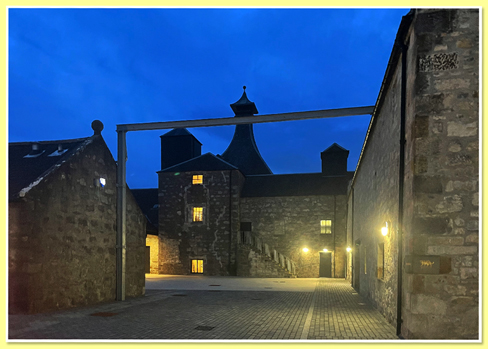
|
| Brora by night, June 2024 (WF Archive) |
It’s highly unusual here to compare two whiskies from different distilleries, but after all, both are part of the Diageo stable, and one might not exist without the other. Indeed, it’s well known that the shortage of peated whisky production on Islay at a time when demand for "smoky" blends like Johnnie Walker was on the rise led Diageo’s predecessor, the D.C.L., to seek alternatives on the mainland. Following experiments at several distilleries, they eventually settled on the disused Clynelish distillery, which had been closed for two years.
Sure, Port Ellen had been revived in 1967, but Islay faced a severe drought in 1968, and Caol Ila at the time was much smaller than it is today. Interestingly, after several trials using malted barley from Ord, it was in May 1969 that the DCL board concluded that the new peated distillate from Clynelish II (which would officially become Brora in December of that same year) was now “indistinguishable from the output of Lagavulin” as well as from their other two Islay distilleries. In hindsight, such a claim seems exaggerated after having tasted over 160 different expressions, but the legend of Brora was beginning to take shape…
It’s worth noting that other distilleries also started producing heavily peated whiskies around this time, including Glen Garioch, which became part of Bowmore’s portfolio shortly after, Springbank (with Longrow), and Tobermory (producing Ledaig). Perhaps it was during this period that the general public started associating Scotch whisky as a whole with being “smoky.” Even today, you still meet people who shy away from Scotch whisky because they believe it’s all “smoky.” Crazy, isn’t it? |
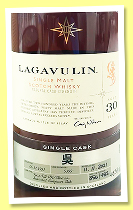
|
Lagavulin 30 yo 1991/2021 (45.5%, OB, Casks of Distinction, First-fill PX/Oloroso seasoned European oak, cask #5399, 482 bottles) 
A Cask of Distinction purchased and bottled for Asia, as many of them are. Occasionally, a few bottles find their way back to Europe, though I must admit I’ve never seen anything from this particular cask, even if we’ve already tasted several of these 1991 ‘COD’ ex-first-fill sherry casks with closely related numbers. As they say, this stuff is dynamite, baby. What’s more, casks with a relatively low ABV often provide some additional surprises. Colour: full gold. Nose: good heavens, such compactness and robustness. To start, it’s like a liquid product designed to clear your sinuses, full of camphor, eucalyptus, and similar notes. Then it begins to unleash a barrage of aromas, each more powerful than the last, not necessarily in a very orderly fashion, but with a sense of overwhelming invasion that you can do nothing to stop. Seaweed, pepper, brine, shellfish, green walnuts, miso, peat smoke, resinous smoke, bitter oranges, myrtle, iodine tincture, balms, thuja wood, tobacco, fresh leather, tar, new rubber, saffron, coriander, fresh plastic… you see, it’s quite monstrous. Did we already mention myrtle? I think it’s time to call in the Anti-Maltoporn Brigade. Mouth: incredibly powerful despite the officially moderate strength, and once again, you feel as if you’ve been silenced (and who said “about time,” eh?). Lots of tar, oysters, liquorice, and both black and green olives, along with anchovies in brine, bitter orange, cinchona, ashes, and simply what we call "peat." A massive sense of satiation—this Lagavulin almost nourishes you—but will the finish keep up at this level, given the ABV?... Finish: oh yes, it does, and this is where it feels the most quintessentially ‘Lagavulin.’ Peppery tar, zest, curry, and more shellfish. Quite an impressive length, with almost refreshing peppermint at the very end. Comments: we told you so, didn’t we? And let’s also say it—there’s even a little nod to ‘Jamaica’s HMPDN’.
SGP:567 - 93 points. |
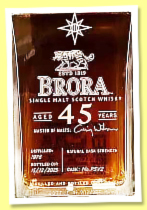
|
Brora 45 yo 1978/2023 (49.4%, OB, Casks of Distinction, cask #P5V2, 255 bottles, 2024) 
A new Cask of Distinction presented in the legendary square decanter rather than the series’ traditional bottle, and bottled exactly one year ago, on 15 December 2023. At Diageo, there often seems to be a ‘certain time’ between bottling and the release of these prestigious series. I’ll add that, in theory, these 1978s are generally less peaty than the early 1970s, of course, but also some 1977s, which are relatively uncommon yet have recently surprised us with their power. Colour: pure gold. Nose: you cannot deny a certain kinship with Lagavulin, though let’s say this is less ‘coastal’ and more about waxes, putty, and turpentine. It’s also less medicinal overall, more refined and elegant, with essential oils, a faint farmy touch often noted in the past (think an impeccably clean stable, with saddle leather), and Japanese seaweed—wakame and the like—served with fresh langoustines, all laid on a bed of clay. In short, on the nose this is a rather delicate and elegant 1978 Brora, with smoke that envelops everything but never tries to dominate. Mouth: very distinctive, markedly further from Lagavulin on the palate, leaning more towards top-quality green teas, soft resins, and citrus zests, followed by a slightly peppery and petrol-like character with a faint prickle. Pine bud-steamed fish, gum arabic, a touch of fresh rubber, then hints of yellow chartreuse and peppery honey. To be honest, it becomes increasingly "Brora" as it evolves. With a drop of water just to test: the salinity comes to the forefront, with an overall profile reminiscent of an old Talisker, which won’t surprise many. Magnificent. Finish: good length, eminently Brora, more lemony, more peppery, and more... medicinal. The oak is more prominent in the aftertaste—it may be that a few more years would have been slightly excessive. Comments: an old Brora that edges into the ‘resinous era’ after 45 years in the cask. Well, that suits it beautifully. The Lagavulin had a modern touch, while this Brora feels more, let’s say, traditional. We think it would be inelegant to assign them different scores.
SGP:465 - 93 points. |
Excuse me? Port Ellen? But of course! We’ve already tasted quite a few fairly young PEs this month, though I’m not sure whether they’ll have been published by the time you read this (no that’s tomorrow – S.). No matter—let’s add another, slightly ‘older’ Port Ellen to this little session. |
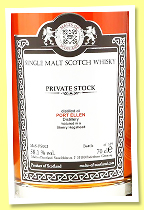
|
Port Ellen 1982/2024 (58.1%, Malts of Scotland, Private Stock, sherry hogshead, cask #MoS PS002, 169 bottles) 
2023 and 2024 have been landmark years for Malts of Scotland and their líder máximo Thomas, with numerous quite breath-taking releases that, most importantly, have been markedly different from what most other independents typically offer. While others often release batches in waves—think Teaninich, Fettercairn, Benrinnes, Ben Nevis, Benriach, Loch Lomond, Glen Scotia, Inchgower, Glentauchers, Ledaig, or the secret Laphroaigs, Ardbegs, HPs, or even the mythical Malt Mills (just joking)— ‘MoS’ has taken a different approach, and this remarkable Port Ellen is a perfect example. Unless, of course, a wave of independent Port Ellens is on the horizon, though that seems unlikely, doesn’t it? Colour: amber. Nose: despite the age, this is more brutal, more rustic than Brora, peatier too, more mineral, almost chalky, and of course tarry. There are also pencil shavings, more chocolate, and coffee, undoubtedly from the sherry cask. Sour cherry jam and tobacco are present as well, but ultimately, it’s the coal tar that rules the roost at cask strength. With water: not much change, except it sharpens up dramatically, which we thoroughly enjoy. A striking mineral precision, quite unexpected from a sherry cask, along with hints of verbena and absinthe ‘just for fun.’ Overall, it’s a touch more compact than the noses of the other two. Mouth (neat): immensely powerful, packed with ashes and peppery lemon. What a beast! It even evokes holly eau-de-vie—sadly hard to find these days, as no one seems to drink it anymore. Philistines! With water: tighter, almost youthful, saltier, and still ultra-precise. Pepper and hints of pine bark (or something similar). Finish: extremely long, almost violent at this stage—this is precisely what struck us in the first Port Ellens, like the Rare Malts. The aftertaste brings liquorice, resins, and salted tar. No prisoners. Comments: let’s stay gentlemen—there’s no question of scoring this one higher than the others.
SGP:567 - 93 points. |
… I must admit to having a very, very slight preference for the Brora in the end, due to its extra touch of elegance. Right then, until next time! |
(Danke schoen Dave, Gene, and Wei Jie) |
| |
December 23, 2024 |
|
  |

|
Catching up with Octomore and chasing the ppms |
It’s not exactly easy to put together a flight of Octomores—the idea always feels a bit intimidating, especially since you already know that nothing will be able to follow them. But this time, we’re going for it! We’ll rank them simply by ascending ABV… By the way, we haven’t yet tried blending Octomore with HD ‘<DOK’, but I promise we’ll get around to it one of these days—stay tuned.
|
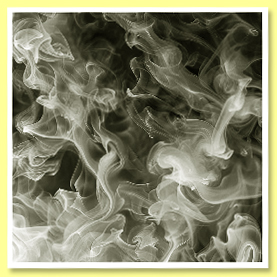 |
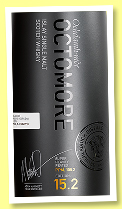
|
Octomore 5 yo 2017/2023 'Edition 15.2' (57.9%, OB, refill wine and bourbon + cognac finish) 
At 108.2ppm, this is ‘super heavily peated’, you understand. The rationale for a cognac cask finish seems rather obscure in this context—perhaps they simply had a few cognac casks lying around. Scottish logic, in a way. Colour: white wine. Nose: we’re straight into a pharmacy, while someone nearby is having a barbecue. Masses of mercurochrome and just the impression of visiting working maltings at full throttle (while they’re doing peat, of course). With water: why on earth do we feel like we’ve got our heads in an extinguished fireplace? Mouth (neat): lemon, apple, gentian, pepper, smoke, toothpaste. This means business. With water: it becomes almost simplistic, yet it’s very elegant. Smoked mint. Finish: long, more saline and lemonier. Not the faintest trace of cognac. Comments: very clean, very pure. I repeat, don’t worry, no detectable cognac here—this isn’t some trans-blend. And we love cognac.
SGP:468 - 88 points. |
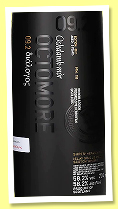
|
Octomore 5 yo 2012/2018 'Edition 9.2' (58.2%, OB, Bordeaux finish, 12000 bottles) 
This is just about plugging a gap—we’d never tasted this version before, though the idea of finishing a whisky made from malted barley measured at 156ppm peat in Bordeaux casks never sounded particularly appetising. Colour: orange/apricot. Nose: frankly, it’s all right, but you do get piperade, cooked peppers, blackcurrant buds, bay leaves, and new trainers (that’ll be the malt) … Even with 156ppm. With water: stale crème de cassis and cooked peppers. Perhaps as a sauce, on fajitas? Mouth (neat): too much. This is no longer whisky—it’s a liquid assault. Massive doses of smoked blackcurrants, chlorophyll mixed with cherries... You move on quickly. With water: phew, it calms down, you get back to earth, and it becomes almost drinkable, despite the Bordeaux pepperiness—it’s almost like completely unhinged cabernet franc. Finish: long, bitter, almost spicy. The pepper is still there, and so is the cassis. Comments: this is really very improbable—and almost unscorable. I’m giving it a score almost at random, let’s go with that.
SGP:578 - 70 points. |
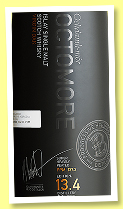
|
Octomore 5 yo 2016/2022 'Edition 13.4' (61.6%, OB, The Impossible Equation, virgin oak finish, 3,500 bottles) 
137.3ppm. Colour: gold. Nose: but of course, vanilla, ripe bananas, apples, and papayas, with peat that’s ultimately rather discreet, alongside a touch of thyme honey. With water: oh lovely—sauna oils, hints of mint essence and eucalyptus… The rather vanillin-led edge is eradicated. Mouth (neat): typical active oak, though the distillate can handle it all. Very nice peppers, citrus peels, camphor and eucalyptus, cough syrup, ginger… There’s a certain simplicity, but everything works perfectly. With water: pencil shavings, as expected, though it stays within reasonable bounds. Finish: long, sweeter, with assorted sweets. Foam bananas. Comments: it retains a slightly young and doctored feel, yet I must confess, without shame, that I rather like it.
SGP:567 - 86 points. |
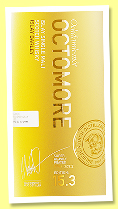
|
Octomore 5 yo 2018/2024 'Edition 15.3' (61.3%, OB, The Impossible Equation) 
307.2ppm this time. It reminds me of Motörhead in the 1970s, trying to play as loud as possible (‘If we move in next door to you, your lawn will die’). All the barley comes from Octomore Farm on Islay, with bourbon casks and Fernando de Castilla casks from Jerez. Colour: light gold. Nose: as usual, you don’t immediately sense ‘the ppm’, and frankly, we know Port Charlotte examples that taste much more ‘peated’. We’ll soon have dozens of Port Charlottes on WF, by the way. Anyway, this is a relatively gentle Octomore for now, more on ashes and ripe apples, even honey. With water: fresh bread, ashes, brine, sourdough. Mouth (neat): very ‘eau-de-vie’, kirsch… Frankly, it feels a little too young at this stage, although we do quite like that mezcal-like side that also appears. With water: the citrus explodes onto the scene, while the whole thing turns brutal. The more water you add (up to a certain point), the more you erase the sweetness of the alcohol and the more those d****d 370.2ppm come through—it’s worse than a noose. Finish: very long, more bitter, peppery, with a base of pickled lemons in brine. Chilli peppers in the aftertaste. Comments: actually, it’s really extreme—at first, you’d think it’s almost rotgut, but in reality… Rather love.
SGP:479 - 87 points. |
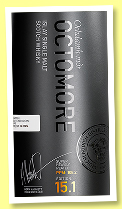
|
Octomore 5 yo 2018/2024 'Edition 15.1' (59.1%, OB, The Impossible Equation, bourbon + recharred bourbon) 
108.2ppm—child’s play. Colour: straw. Nose: soft, almost gentle, with Bruichladdich’s signature melon and a touch of meadow honey. I’ve heard that on Islay, when the wind picks up, bees know to fly close to the ground. You might say we do the same after visiting the distilleries, gliding just above ground level. Anyway, this is a gentle Octomore, but I repeat, the real ‘beasts’ are some of the Port Charlottes. With water: it stays close to chalk, Islay soil, and the wool of its sheep… Mouth (neat): no, this is very good—powerful, saline, with no alien aromas along the way, focused on an intensely rendered lemon and Loch Indaal water. Oh, we’ve tasted it many times. The pepper is spot-on. With water: yes! An avalanche of ashes, gherkins, and small oysters. Finish: long, on ashes, smoked kippers, and perhaps even an olive. A little cough sweet lingers in the aftertaste. Comments: my favourite so far—definitely more complex than the others, though it’s crucial to dilute it well and not play the cowboy; the distillers already do enough of that.
SGP:457 - 89 points. |
We dream of a well-aged Octomore, and above all, one coming from a cask—or several—that they’ve just left to rest ‘nice and easy’. I’m sure it exists. In short, a simple bourbon barrel or a refill hoggie to round off this session would be perfect… |
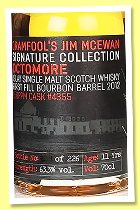
|
Octomore 11 yo 2012/2024 (63.3%, Dramfool, Jim McEwan Signature Collection, first fill bourbon barrel, cask #4355, Release 9.3, 226 bottles) 
156ppm, but who’s counting? Colour: straw. Nose: we’re back to hospitals and linoleum, iodine tincture, fresh plaster, damp chalk, mercurochrome, fireplace ashes, and cigarette ash (ashtray at 5 a.m.—if memory serves), then pickled gherkins and even olives. We love all that, Big Jim. With water: the barley takes charge, much more than the peat. Or perhaps, ‘a massive bag of oatcakes’. Mouth (neat): sweetness from the alcohol, pear eau-de-vie, plum eau-de-vie—almost a vodka-like side, but don’t get me wrong, this is anything but a criticism. In any case, no one’s supposed to drink whisky at 63.3%, not even in ridiculous American superhero films. With water: and here come fruit peelings, freshly malted barley perfumed with peat (or an old kiln in operation), followed by those famous olives. The little pink olives from the Maghreb… Finish: long, saline, briny, with tar, liquorice, olives, oysters, anchovies, ashes, and so on… Comments: we’ve found our 90. This is a magnificent ‘no-wine’ bottling.
SGP:467 - 90 points. |
| |
December 22, 2024 |
|
  |

|
|
A word of caution
Let me please remind you that my humble assessments of any spirits are done from the point of view of a malt whisky enthusiast who, what's more, is aboslutely not an expert in rum, brandy, tequila, vodka, gin or any other spirits. Thank you – and peace! |

|
A few more excellent rums
for Christmas |
It’s winter. Across the vast, frozen Alsatian landscapes, where the pristine whiteness of snow blends with the dancing shadows of frost-covered vineyards, the wind rises in a wild symphony. It howls, slips through the bare vines, whips the snowy ridges, carrying with it an ancient echo: the distant howling of wolves. Well, just kidding—the weather’s actually quite pleasant during this festive season. But that’s no excuse not to warm ourselves up with a few summery rums chosen more or less randomly. With apéritif, naturally… |
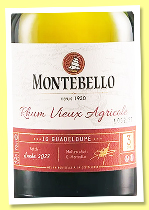
|
Montebello 3 yo ‘Rhum Vieux Agricole’ (42%, OB, Guadeloupe, 2022) 
The bottle proudly displays its Guadeloupe Geographical Indication (IG). This is one of those French distilleries we do not come across very often, but then we are but humble whisky geeks, are we not. Colour: gold. Nose: this is rather singular, with a caramelised sugar side, muscovado, and above all, it is heavily marked by jasmine and wisteria. Notes of slightly earthy honey and sweet woodruff follow. It certainly has character. Mouth: the nose carries through to the palate, particularly with jasmine tea and fresh cane juice, then candy sugar and light aniseed touches. The profile is fresh and rather unusual. Finish: of medium length, leaning more towards bitter orange with a hint of lavender and tar. Always a touch of anise. Comments: I really enjoy this unusual profile.
SGP:552 - 84 points. |
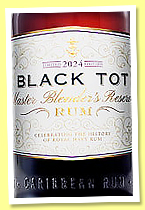
|
Black Tot ‘Master Blender’s Reserve 2024’ (54.5%, Elixir Distillers, blended rum) 
A very British blend, featuring Jamaican, Barbadian, Guyanese, and… Caroni! The 2023 edition was rather glorious, the 2022 as well, and the 2021 was quite delightful. Colour: gold. Nose: it opens with cane juice, almost like an agricole, before moving towards the oily and tarry notes typical of these islands, though softened and more restrained than in your usual Jamaican or Trinidadian examples (though those are never really ‘usual,’ are they). Barbados seems to add the sweetness and kindness (with bananas and pineapples). However, I’m unsure which country contributes those lovely roasted peanut notes. With water: little change, perhaps a drop of lapsang souchong tea. Mouth (neat): balances often shift on the palate, and that’s the case here, as liquorice, tar, and even salt take the lead this time. More demerara sugar, roasted bananas, and stranger honeys emerge. With water: it rounds out, while more stewed citrus fruits appear. Finish: of medium length, somewhat even softer. Cane juice returns in the aftertaste, joined by orange juice. Comments: very well-balanced, which seems perfectly suited to a rum for sailors, doesn’t it.
SGP:652 - 87 points. |
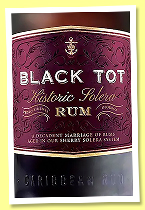
|
Black Tot ‘Historic Solera’ (46.2%, Elixir Distillers, blended rum, 2024) 
This is ‘aged in a sherry solera system’. It appears there are three criaderas. Colour: copper amber. Nose: I may shock a few friends, but I believe this is exactly how brandies de Jerez should express themselves. The blend clearly delivers notes of sulphur (stone), tar, and fresh rubber, yet I find it works perfectly. Also prunes, mussels, seawater, and fuel oil… It’s rather unusual, but I love it. Mouth: it’s almost like chewing on a new rubber boot, with pepper, tobacco, PX, and slightly acidic coffee—which is delightful. Finish: long, peppery, fairly smoky, with hints of tomato leaf and cassis buds. Prunes. Comments: utterly improbable, yet perfectly excellent. Boldly done, rather love it…
SGP:562 - 88 points. |
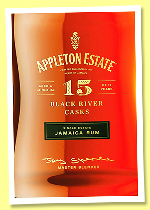
|
Appleton 15 yo ‘Black River Casks’ (43%, OB, Jamaica, +/-2024) 
A pot still and column rum, aged—or more likely re-racked—in ex-casks from their sister distillery, Wild Turkey in Lawrenceburg. We already love the straightforward Appleton ‘Signature’. Colour: deep gold. Nose: this is really very beautiful, very elegant, almost discreet but with a rather evident ‘pot still’ character, orange cake, and indeed a bourbon-like side (vanilla and gentle varnish), along with lovely touches of rubber again (bicycle inner tube), mocha, and mandarins with a hint of honey. Mouth: we feared it might feel a little weak, but not at all—it’s just soft, fresh, and elegant. Jaffa cakes, honey, praline, and a touch of salted liquorice that highlights its Jamaican origin. It dips a little afterwards, due to the lower strength, but let’s not exaggerate—it holds up very well. Finish: slightly short, with roasted nuts and a hint of honeyed marmalade. Comments: superb, even if I prefer the ‘Signature’, which is purer and more direct.
SGP:551 - 85 points. |
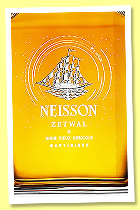
|
Neisson ‘Zetwal Sirius’ (49.2%, OB, LMDW Foundations, Martinique, 2024) 
A blend of self rums distilled in Savalle column still between 2001 and 2013. The price is very high (€2K), but once empty, the bottle will make a lovely vase. Just joking, but I absolutely a-do-red the 2023 version of this Zetwal (WF 93). As a reminder, in Creole, Zetwal = étoile = star. Colour: deep gold. Nose: this is truly an aromatic bomb, packed with fresh and dried fruits, white and milk chocolate, yellow flowers, fine chardonnay (including top champagne from the Côte des Blancs), soft spices around caraway, and all things almond-related (biscuits, creams, oils, whatnot). There are countless smaller aromas—herbs, flowers, spices, citrus—that simply need a little time to unfold. In short, not a rum for savages (just kidding). Mouth: I don’t think I need to add much—this is simply one of the greatest ‘modern’ rums of the moment. Everything we found on the nose carries through to the palate, with just a little more room for citrus and woody spices. Finish: long, smooth, still on citrus and wood (cedar, oak, sandalwood). A woodier aftertaste. Comments: as our dear grandmothers used to say, the price is forgotten, but the quality remains. This new Zetwal 'Sirius' feels just a touch woodier compared to last year’s, but it’s still absolutely top-notch.
SGP:662 - 91 points. |
PS: Maybe someone should have mentioned the famous Dalmore 1967 'Sirius' to them—the one that led all our English-speaking friends to crack that cheeky little joke when it was released: "Are you Sirius?" But hey, I'm just saying—at the end of the day, the quality is exceptionally high. |
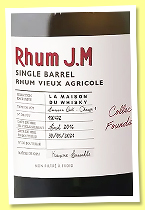
|
Rhum J.M 8 yo 2016/2024 (56.7%, OB, Martinique, LMDW Foundations, American oak, cask #150472) 
It must be said, La Maison du Whisky has released an impressive collection of rums this autumn. J.M has pursued a very active cask policy for some time now, with results that seem rather convincing despite a tendency to display quite a bit of pencil shavings. The label specifies ‘single cask’, but rest assured, it is indeed a ‘fût unique’, ha. Colour: deep gold. Nose: again, it must be said, the heavily charred American oak and agricole rum work well together, almost doubling the number of ripe mangoes, equally ripe bananas, and all those exotic fruits we so love. Add manuka honey, pine and cedar wood, along with liquorice wood. With water: it softens further, with maple syrup and a lovely earthy, mentholated side. Mouth (neat): rich, spicy, and very oaky, though not in a bad way. Bold ginger and cinnamon, then Russian-style black tea. Bananas and citrus remain quietly in the background, while pine wood takes centre stage. With water: as is often the case, water steps in to restore order, putting the flavours back in their places. The woody side, which might have seemed excessive, now feels better integrated. Finish: long, softer. A bit of camphor, liquorice… and still quite a bit of cedar wood. Comments: very much in the modern style. I find this very good.
SGP:561 - 86 points. |
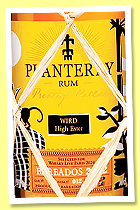
|
WIRD 2 yo 2022/2024 ‘High Ester’ (59%, Planteray, Barbados, Whisky Live 2024, 300 bottles) 
The West Indies Rum Distillery, by far the largest distillery in Barbados, has belonged to Cognac Ferrand since 2017. This rum is double-distilled in a pot still (a replica of an old John Dore). I’m not exactly sure what ester level we’re dealing with here, but let’s approach it without preconceptions. Colour: pale gold. Nose: definitely high-ester in style, with just the right amount of rubber boots, coal tar, cider vinegar, olives, and antiseptic. In the background, the expected overripe bananas and crushed black pepper. With water: it barely calms down, still holding onto peppery rubber notes. Mouth (neat): very powerful, with a highly peppery style that sets it apart from Jamaican high-esters, then leaning more towards a rooty profile (gentian, wild carrot) while passing through very ripe exotic fruits (bordering on ammonia—we love that). With water: it ‘scrapes’ a little now, which we also enjoy. Roots and pepper plus lemon peel. Finish: long, with a fino-like edge. Basalt, fresh walnuts, brine, varnish, and orange cake. Comments: its two years of age have never been an issue. A very good alternative to the Jamaicans and the grand-arômes from France.
SGP:562 - 86 points. |
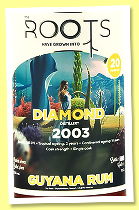
|
Diamond 20 yo 2003/2024 (51.6% The Roots, Guyana, bourbon cask, 174 bottles) 
Ex-French Savalle column (in copper), which would suggest an ‘Uitvlugt’ origin. Colour: copper amber. Nose: this is almost entirely about olives! And God knows we love olives. Magnificent black tapenade (with anchovies, of course). With water: lovage and prunes come in to complete the picture. An amusing combination. Mouth (neat): very unusual, slightly astringent, loaded with peppered chocolate this time, with some paint-like notes over the top. With water: the water dissolves everything and brings out much gentler stewed fruits. Apple compote with liquorice, a pinch of salt, and a drop of tequila. Finish: fairly long, with a hint of turpentine. That too dissolves the paint. Mocha and very dark tea. Comments: bonus points for the originality of the profile.
SGP:462 - 87 points. |
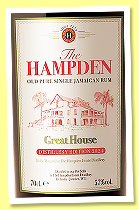
|
Hampden 'Great House Distillery Edition 2024' (57%, OB, Jamaica) 
Previous editions had been nothing short of perfect, highly emblematic of the Hampden style, transcending marques, ages, and vintages. In theory, there’s no reason why 2024 should be any different, is there? So, let’s get straight to it… Colour: straw. Nose: rather gentle but packed with all its usual attributes—fermented fruits, acetone, varnish, olives, seawater, tar, and carbon. With water: small touches of white radish and molasses join the mix. Mouth (neat): salted liquorice, sharper apple juice, lemon juice, varnish, and brine. With water: similar, with the addition of a little cane sugar and pepper. A hint of glutamate and clove. Finish: long, salty, peppery, maritime, and tarry. Comments: the perfect Christmas gift for those who love rum but haven’t yet discovered the Jamaican ‘high-ester’ style. Oh dear, it seems I’ve just made a purchase recommendation… I’m sorry. This edition feels a touch softer than the others, I believe.
SGP:463 - 89 points. |
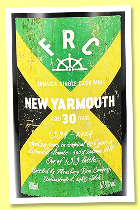
|
New Yarmouth 30 yo 1994/2024 (67.6%, FRC, Jamaica, 199 bottles) 
Matured in Jamaica for the first 24 years, I suppose this qualifies as ‘tropical aging’. Remember FRC = Flensburg Rum Company, Flensburg being a German city that’s ‘almost in Denmark’. Will they ever forgive me for writing that? Colour: dark amber. Nose: lovage and pipe tobacco, then thyme honey, maple syrup, and old Armagnac. Hints of tar. There’s a surprisingly compact side here, but let’s not forget—67.6% ABV—a further testament to tropical aging. With water: cherry and fir resin, fig tree sap. Careful, fig tree sap is toxic on contact. Mouth (neat): cough syrup at cask strength. It stings a bit, I admit. Concentrated lemon, fresh tarmac, and extreme pepper. Quick… With water: it remains very concentrated, thick, drier, spicier, and woodier too, but still within more than acceptable limits for me. Finish: very long, dry, almost austere. Bitter chocolate, pepper, and salted liquorice. Honey and orange zest bring a touch of sweetness in the aftertaste. Comments: I love it, but it’s exactly the opposite of a ‘perfect Christmas gift for those who enjoy rum but don’t yet know the Jamaican high-ester style.’ Sorry, ite Missa est, this is probably more a ‘connoisseur’s rum’, whatever that means.
SGP:472 - 90 points. |
 Check the index of all rums we've tasted so far Check the index of all rums we've tasted so far
|
| |
December 21, 2024 |
|
  |

|
Five Miyagikyo
and a Remarkable Bonus |
Miyagikyo doesn’t quite have the same reputation as Yoichi, but we’ve already tasted some marvellous ones, even if there have been rather few in recent years, following a wave of releases between 2005 and 2015. As for today’s bonus, hold on tight...
Nikka's Miyagikyo Sendai (Nikka)
|
 |
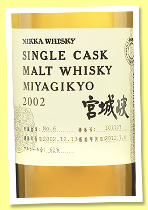
|
Miyagikyo 9 yo 2002/2012 (62%, OB, refill butt, cask #101127, Warehouse #6, 517 bottles) 
Probably a young, highly concentrated Miyagikyo. Colour: golden. Nose: imagine a fruit salad drizzled with fir honey—apples, bananas, pears, pineapples, mangoes, and vanilla. The whole is almost supremely simple, which in this case is far from a flaw. Water should nonetheless bring out more complexity. With water: few changes, though perhaps more kiwi and rhubarb, which add a Sauvignon Blanc-like tension. Malted barley and orange cake also join the mix. Mouth: little sour candies, fruit liqueurs, passion fruits, and lime. Again, this incredible simplicity at high strength. With water: still the simplicity of fresh fruits with a few English sweets. Finish: medium length, with similar flavours. A touch of fir bud liqueur on the aftertaste and a hint of sweet woodruff syrup. We adore it. Comments: a little fruity bomb, perfectly crafted in all its simplicity.
SGP:641 - 87 points. |
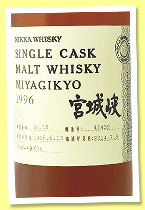
|
Miyagikyo 18 yo 1996/2014 (62%, OB, La Maison du Whisky, Light Peat, remade hogshead, cask #42439, Warehouse #18) 
Like Yoichi, Miyagikyo seems to have alternated between rather peaty versions and unpeated ones, the latter of which appear to be in the majority. Colour: gold. Nose: a magnificent arrival on the nose, with citrus fruits, seaweed, ashes, camphor, and kumquats, followed by a clearly evident great white wine character. Think of a grand white Burgundy, for example. Impressive touches of honeysuckle, quince, and mirabelle plums, even evoking a great Blanc de Blancs Champagne. Splendid and incredibly gentle. Three drops of diesel in the background, likely from the peat. With water: fresh mastic, pencil eraser, carbon paper, cigar ash, and a very light note of wet dog. Mouth: exceptional, both taut and oily at once, with citrus peels, yuzu, a small smoked oyster (a Korean specialty), Sichuan pepper, and a tiny spicy touch... It’s superb. With water: evokes old citrus- and herb-based liqueurs, though hard to pin down precisely. Light saline and mineral notes, chalk, clay, and once again a grand white Burgundy. Finish: medium length but with perfect structure. Citrus, mint, light smoke, resins, and a touch of hydrocarbons at the end. Comments: we had already tasted some 1996, but not this cask. I find this immensely good.
SGP:552 - 91 points. |
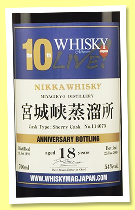
|
Miyagikyo 18 yo 1991/2009 ‘Whisky Live Tokyo 10th Anniversary’ (54%, OB, sherry butt, cask #114675) 
When it comes to first-fill sherry, our Japanese friends sometimes go for emphasis, even excess, though excess often pays off, as we’ve seen with other famous distilleries like Yamazaki and, of course, Karuizawa. Colour: golden bronze. Nose: an old tin box packed to the brim with aged sultanas, then another filled with figs and dried dates. This immediately brings to mind PX or cream sherry casks, though with elegance. Prunes, old Malvasia, and slightly ‘dressed’ vintage Cognac also come to mind. The dates eventually take the lead. With water: a touch of potting soil, a few mushrooms, and some coffee grounds. Mouth: very rich, creamy, almost sweet, with muscat and indeed PX. Then aged plum eau-de-vie, liqueur-filled chocolate, spiced damsons, and those explosively juicy sultanas again. It’s sweet and indulgent. With water: a faint metallic edge emerges, along with some slightly tart fruits (starfruit, physalis) and walnut liqueur. Inevitably reminiscent of certain Speyside whiskies heavily influenced by sherry. Finish: long, mainly on melted chocolate and prunes. Comments: I rather suspect this came from a genuine solera butt, though I could be mistaken. What’s often called a "sherry monster" in whisky parlance.
SGP:751 - 88 points. |
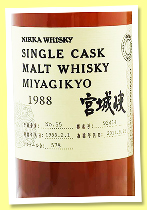
|
Miyagikyo 23 yo 1988/2011 (57%, OB, cask #92414, Warehouse #55) 
It seems they have at least fifty-five warehouses at Miyagikyo, unless that's for the whole of Nikka. Colour: gold. Nose: shares certain traits with the 1991, but with far more elegance—subtle herbs, flowers like jasmine and wisteria, then indeed sultanas and vintage Cognac with a hint of peach liqueur. There’s also a touch of Iberian ham, plum wine, Corinth raisins, cinchona, and hints of juniper. A very, very lovely nose. With water: everything honeyed comes forward, with a trace of rum. Mouth: loads of spices—pepper, black tea tannins, dried mandarin peels (chen-pi), then honey, maple syrup, and a touch of molasses. Plenty of rancio, with notes of Maury and Rivesaltes. It certainly doesn’t hold back this time. With water: it seems we’ve tamed it. Very charming sweet-savoury and bittersweet qualities emerge—prunes, raisins, ham, marzipan, black tea... Finish: long, more chocolatey and spiced. There’s a little note of aged juniper and bitter almond liqueur, which we find delightful. Comments: an old Miyagikyo with plenty to say if you give it time. Adding water is, of course, recommended but must be done sparingly to avoid drying it out suddenly.
SGP:651 - 90 points. |
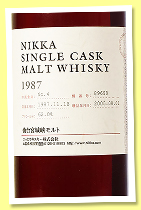
|
Miyagikyo 17 yo 1987/2005 (62%, OB, sherry cask, cask #89698, Warehouse #4) 
Another sherry, which we imagine to be quite pronounced once again. Colour: coffee. Nose: we’re fully in the style of a great Speyside whisky from an excellent first-fill sherry cask—be it from Craigellachie, Dufftown, or Ballindalloch. In other words, there’s no distinctly "Japanese" character here, but rather an abundance of coffee liqueur, Corinth raisins, pipe tobacco, prunes, old-school Armagnac, dark chocolate, very dark honey, candied sugar, with a hint of mint and soy sauce. With water: roasted nuts, a percolator in full swing, chocolate cake fresh from the oven, and plum tart, also just out of the oven. Mouth: a massive, extreme sherry profile, peppery and heavily marked by dark chocolate. A bit rough in cask strength form—it definitely needs water. With water: a touch of broth, lemon juice, thyme, slightly burnt walnuts, and plenty of bitter chocolate. Finish: very long, with black tea, espresso coffee, and bitter chocolate. It takes no prisoners. Roasted pecans and dark tobacco linger in the aftertaste. Comments: one might say that when a Japanese distiller labels something "sherry," they truly mean it. In any case, this bottling is perfect, despite—or perhaps because of—its slightly excessive nature.
SGP:652 - 90 points. |
And now, blow your trumpets, Christmas angels... |
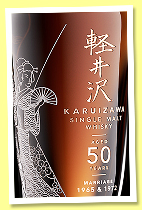
|
Karuizawa 50 yo 1965+1972/2024 ‘The Marriage’ (54.8%, The Whisky Exchange Cabinet, 50 bottles) 
80% 1965 and 20% 1972, married for two years. Sold as an NFT but thank heavens it’s not a ‘mini-NFT’ we’re swirling in the tulip glass. A brief recap for newcomers: one of whisky’s greatest mysteries remains why the official Karuizawas from owners Mercian/Kirin, or the pure malts they produced in the 1980s and 1990s (8 - 10 - 12 - 15 - 17 - 21 yo), remained rather modest in both quality and reputation, despite earning international medals (which, let’s face it, everyone has). In Europe, at least, no one was particularly interested if you spotted a bottle here or there at a festival. Karui…what? Then, discerning enthusiasts unearthed far superior single casks in Japan (kudos to our friend Bert Vuik!), shared them, and soon, ‘savvy investors’ began taking notice, purchasing remaining stocks from the now-closed distillery. The larger distributors in London, Paris, and elsewhere started releasing the first ‘modern’ Karuizawas, the vast majority of exceptional quality. Prices skyrocketed, and the rest is history. More recently, a new Karuizawa distillery has been established, though their first whisky isn’t expected until the 2030s. Let’s savour this new 50-year-old... Colour: amber. Nose: from the first whiff, we encounter a fairly classic old Armagnac profile, with prunes taking the lead. But that doesn’t last long, as malt, coffee, mint, and tar soon assert themselves, followed by the scent of old books found in the attic and a basket brimming with dried fruits—dates and figs in particular. Ultimately, it begins to resemble a Springbank LB ex-sherry distilled around 1965–1966 (what a coincidence!) ... and perhaps a touch of M. from those years too. A grand vintage effect that seems to have travelled from Scotland all the way to Japan. With water: peach jam enters the fray, lending a genuine quality of a kind of blend of old ‘M’ (Golden Promise) and old folle blanche armagnac. A faintly earthy/sulphury edge, typical of Karuizawa ex-sherry, emerges next. But we’re talking good sulphur, ala M. from Dufftown. Menthol hovers in the background. Mouth (neat): immensely rich, immediately focused on dried fruits and pipe tobacco. Dates, figs, pears, raisins, and indeed prunes, alongside toffee, hints of ancient absinthe and verbena, and increasingly minty tones of all sorts intertwined with liquorice and very old pu-ehr tea. These almost lend a faintly refreshing quality. With water: a deeply honeyed, fruity tobacco (think orange marmalade) claims dominance over the aromatic landscape. Echoes of an extraordinarily old sherry V.O.R.S. reappear. Finish: wonderfully tertiary, brimming with notes of leather, exquisite pepper, and tobacco. Lingering peppered orange marmalade and ultra-dark chocolate take centre stage in the aftertaste. Though the finish is notably woody, here that’s far from a flaw, on the contrary. One’s mind drifts back to a venerable old armagnac. Comments: the only slight pity is that it was entirely as expected—utterly magical.
SGP:662 - 93 points. |
(Huge thanks to the Golden Promise bar in Paris and to Whisky Magazine & Fine Spirits) |
| |
December 20, 2024 |
|
  |

|
Five vintage Yoichi, including an absolute gem |
Beyond the more commonly known Japanese blends, Yoichi stood out as one of the four exceptional single malts from the Land of the Rising Sun that were already gaining recognition in Europe before the year 2000. A true jewel of the Nikka group, the Yoichi distillery was founded in 1934. The other three were Miyagikyo (established in 1969, also part of Nikka) and the two icons of Suntory: Yamazaki (1923) and Hakushu (1973).
(Photograph Nikka)
|
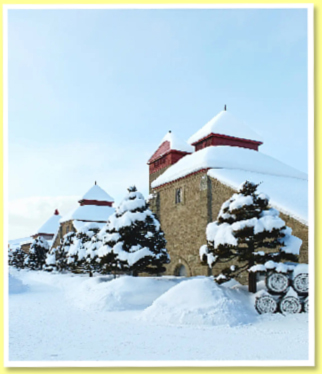 |
At the time, other Japanese malts were still relatively niche, including Karuizawa (1955–2001), which only truly came to our attention in 2007. By then, its then-owners, the Kirin Group, had already announced that no new single malts would be produced in the future, with only the remaining stock available. Here, we present five Yoichis that are already rather old and steeped in history. |
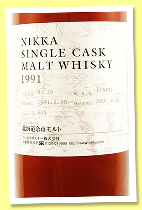
|
Yoichi 16 yo 1991/2007 (62%, OB, oak cask, cask #129493, Warehouse #15) 
A Yoichi that left a strong impression on me when I first tried it some fifteen years ago. I’ll add that I’ve always been fond of the charming simplicity of the term ‘oak cask’. So understated, and that’s just perfect. Colour: dark gold. Nose: the oily texture of this malt is already apparent on the nose! Seems to be a heavily peated version, with lots of resinous wood ash, some coal, and the bergamots of Nancy, even a touch of fatty ham. Then, a clearer line emerges with roasted chestnuts, camphor, and sauna oils. That Japanese character feels prominent. A magnificent nose so far. With water: an exquisite dance of waxes, fresh putty, camphor, and assorted peppers, including Sichuan pepper. Mouth: rich and indeed oily, but those little citrus notes, led by bergamot, bring immediate and wonderful freshness. In the background, some lovely bitters that give it an almost Italian edge. With water: a fat, smoky peat takes the reins. Impressions of smoked olive oil and green walnuts follow. Finish: long, still oily but never tiring. There’s a subtle salty, minty touch and naturally spiced olive oil. Comments: I haven’t changed my opinion; this is a magnificent Yoichi. No wonder these vintages were instantly celebrated.
SGP:467 - 90 points. |
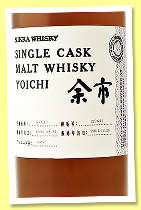
|
Yoichi 20 yo 1991/2011 (63%, OB, Heavily Peated, cask #129651, Warehouse #15) 
A ‘brother’ cask to the previous one, bottled a few years later with a few more years of age. You’d naturally expect plenty of similarities. The inclusion of details like warehouse n°15 is truly a hallmark of these earlier Japanese malts. Colour: deep gold. Nose: you get that saline, citrusy tension again, with fresh mint, spruce wood, a touch of bacon, eucalyptus, and then a sense of an old temple, cedarwood, incense, beeswax… the peat is both prominent and discreet, perfectly integrated without ever veering into that condiment-like profile sometimes found in peated whiskies from other countries. There’s a natural rubbery touch not present in the previous cask. With water: now it’s almost identical to cask n°129493. Waxes, propolis, fresh putty, and green pepper. Mouth: much tauter now, bitter, very peppery, salty, almost a little aggressive. It does need water. With water: loads of olives, capers, amaro, aubergine, ashes… Finish: very long, smoky, on brine, olives, candied citrus peels, cardamom, and coriander seeds. Aftertaste on green peppercorns with a tiny touch of honey and vanilla. Comments: the younger one was a bit more civilised, a little less wild. This twenty-year-old is incredibly energetic but mellows out a bit over time.
SGP:367 - 89 points. |
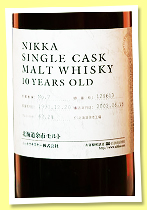
|
Yoichi 11 yo 1990/2002 (62.2%, OB, cask #129613, Warehouse #7) 
All these Yoichi bottlings carried the ‘Nikka’ label, with little focus on the distillery itself back then. Yoichi produced everything from heavily peated malts to virtually unpeated ones, and often it’s only during the tasting that this becomes apparent. Let’s see… Colour: gold. Nose: the wood feels more prominent, more forward, perhaps virgin oak, as the Japanese used virgin oak much more than the Scots did twenty or thirty years ago. Fresh ginger, turmeric, gooseberries, rhubarb, apple peelings, and some humus… With water: a few exotic fruits creep in, banana skin, guavas, slightly underripe papayas… Mouth: a certain sharpness from the wood, green pepper, lemon peel, coriander leaf… Water definitely feels necessary here to calm it all down. With water: an amusing Fins Bois-style cognac note, slightly rustic and herbal. Cider apples stand out strongly. Finish: long, herbal, with green pepper and fir honey. Some lime peel and ginger linger as the signature. Comments: maybe due to its youth, this Yoichi feels a bit rough and dominated by active wood. It should mellow out further after thirty or forty years in the cellar. Yes.
SGP:471 - 87 points. |
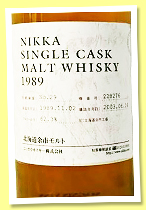
|
Yoichi 13 yo 1989/2003 (62.3%, OB, cask #228276, Warehouse #29) 
Shall we find peat in this other young Yoichi? Colour: pale gold. Nose: a different style, very elegant, with oily notes of sesame and hazelnut oil, wood varnish, fresh pistachios, and once again, banana skin. There’s a very light whiff of smoke (charcoal) and a touch of rhubarb. Hints of high-rye bourbon here and there, though that should fade with a splash of… With water: it becomes more compact but remains lovely, with notes of mushrooms, pine needles, green tea, and thyme… Mouth: rich, powerful, yet taut. Chlorophyll and lemon peel, kirsch, varnish, orgeat, ginger… You might imagine a touch of mizunara here, though that’s not certain. With water: still an oily texture, with grape seed oil and green banana. Those varnish touches persist, followed by hints of cumin and citrusy lemons. Finish: long, herbal, leaning towards heavily infused green tea. Green wood lingers in the aftertaste along with some smoke in the form of lapsang souchong, roasted teas like hojicha, and liquorice. A touch of blackcurrant bud and some tannins as well. Comments: likely a very active cask and a Yoichi that’s remained quite young and vibrant. At times, it feels a bit like fino sherry or even a vin jaune from Arbois, but in the end, it’s distinctly Japanese. Perhaps the least Westernised of true Japanese malts.
SGP:472 - 87 points. |
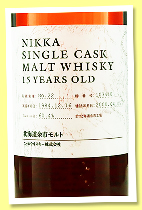
|
Yoichi 15 yo 1984/2000 (60.4%, OB, cask #103440, Warehouse #22) 
1984 was a great vintage for Japanese malt whisky, though that’s purely anecdotal. Besides, we haven’t tasted hundreds of them, alas! Colour: amber gold. Nose: you could stop here, it’s that stunning. Gorgeous wafts of pipe tobacco and menthol, dried figs, chestnut honey, old leather-bound books, Iberian ham, dried meats, morels, old turpentine, and high-quality motor oil… What a whirlwind! With water: beeswax takes over, with even more turpentine and touches of linseed oil. Spruce buds. Mouth: it’s all over. A resinous profile, very pronounced but softened by honey, old ‘medicinal’ liqueurs, verbena, Timut pepper, a faintly lemony hoppy side, and smoked meats… This is absolutely and utterly majestic. With water: a sudden burst of dried fruits, rounded out with a splash of myrtle liqueur. Almost Corsican now. Finish: long, almost refreshing. Mint, wax, and liquorice in perfect balance. Dark chocolate and Pulmoll pastilles in the aftertaste—remember those? Comments: this flirts with the sublime. Di you call the ANMPB? (That’s Anti-Nippon-Malto-Porn Brigade).
SGP:562 - 93 points. |
(Huge thanks to the Golden Promise bar in Paris and to Whisky Magazine & Fine Spirits) |
| |
December 19, 2024 |
|
  |

|
Ardbeg from 2009 to 1989 |
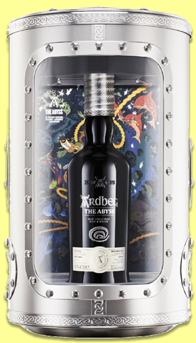 |
There’s starting to be more Ardbeg available again among independents, some going by the sweet name of ‘Kildalton’ (many from 2008-2009-2010), though there was also an official Kildalton, by the way. We’ll be tasting a few of those secret ‘A’s soon, but for now, I’ve rather chosen to wet my lips with three or four ‘disclosed’ Ardbegs before Christmas, both indie bottlings and ‘self’ releases.
What a peculiar object! Is what's inside alive?
|
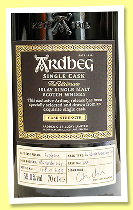
|
Ardbeg 2009/2023 (59%, OB, Feis Ile 2024, 2nd fill Pedro Ximenez sherry butt, cask #3771, 633 bottles) 
It’s only rock and r… I mean PX but it’s 2nd fill, so all’s well in the best of all possible worlds. This shouldn’t be one of those big PX casks that sometimes act as crutches for slightly… wobbly malts. Colour: reddish amber. Nose: well, the PX is indeed present, but it doesn’t seem too out of tune here, especially since the near-extreme wildness of young Ardbeg immediately takes charge, almost erasing the raisins. Trust me. This brings notes of stables and horse saddles, alongside smoked oysters and dried seaweed that are rather spectacular, though water should bring a bit of civilisation to this little monster. With water: there you have it, it’s cleaner, more Ardbeg, more maritime, almost fresher. Crabs, hessian, seawater, old ship ropes… the lot. Impeccable. Mouth (neat): an uppercut to the chin followed by a right hook, it floors you straight away. Are you kidding? Honestly, this is brutal in its natural state. A slight sulphury note, but that could come from the peat, no worries there. With water: oh yes, now we’re talking, a bit raw, a bit rustic, but Islay was never Mayfair anyway. Salt, tar, bacon, mussels, chocolate and two little raisins. Let’s say three. Finish: long, with more ashes and that rubbery tar so typical of ‘Ardbeg’. And a black olive. Comments: I think it might have been even better without the PX, but let’s not complain, it’s excellent.
SGP:568 - 88 points. |
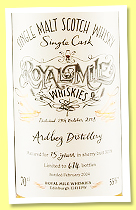
|
Ardbeg 2008/2024 (55%, Royal Mile Whiskies, sherry butt, cask #5078, 614 bottles) 
Since we were bathing in heavy sherry… You’ll say there have been legendary Ardbegs that were aged in sherry, and you’d be right… Colour: gold. Nose: this is the best one yet, you get far less sherry than in the ‘2nd fill’ official version, and it’s more of a tense, zesty Ardbeg, almost lemony at first, then bursting with olives and gherkins, which is magnificent. There’s also a bit of an ester vibe, like its ‘sister distillery’ in Jamaica (strictly a personal impression, mind), with carbon, liquorice, pastis, and two or three rotting fruits… It’s just perfecto. With water: a touch of honey and brown sugar add a gentle roundness to the nose. Speculoos. Mouth (neat): splendid, salty, fresh, lemony, mentholated… but is it even legal to produce something like this? A perfectly perfect texture, and 55% really is the perfect strength. How many times will we use the word ‘perfect’? With water: the lemon, ashes and seawater are now in full riot. There’s even a hint of fuel oil, perhaps – yes, an ‘impression of mazout’. Finish: long, slightly more austere, with notes of charcoal and cigar ash. The olives return after that. Comments: this has everything an Ardbeg should have (so well done, S., you’ve outdone yourself). I’ll add that I really like these very discreet butts, because let’s not forget, they double the number of bottles available!
SGP:468 - 92 points. |
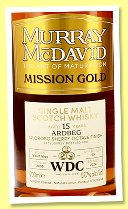
|
Ardbeg 15 yo 2008/2024 (57.7%, Murray McDavid, Mission Gold, for WuDramClan, oloroso sherry octave finish, cask # 2310048, 93 bottles) 
I recently discovered the wordplay with Wu Dram Clan and Wu Tang Clan. I didn’t know Wu Tang Clan—perhaps a generational thing (right). So, it’s not the name of a Chinese triad? Let’s see what this rather bombastic little octave has to offer. Colour: deep gold. Nose: it starts a bit liqueur-like on the nose, almost caramelised, and you’d almost think the octave had been deep-charred too. But the combination works, with bay leaf, sauna oils, earthy tar, dried fruits, roasted pecans, cedarwood (humidor, Cedros de Luxe), and Vicks VapoRub in near-industrial doses. With water: we’re closer to the distillate, hessian, dunnage, creosote, tarry ropes… Mouth (neat): it’s heavy, but it works, with a bit of an American edge. Seriously, you’d think it was a new US malt, very marked by the cask but spectacularly good. Or, let’s say, Millstone from Holland. Camphor, ashes, mint, curry and grilled raisins. It’s certainly not delicate, but that’s not what we’re here for. With water: again, the water brings out the distillate, and it’s rather impressive, particularly the brine and shellfish aspects. Finish: very long, with cask and distillate dancing the tango all night long (what?). Comments: I was worried at certain moments, but everything turned out perfectly. Ardbeg can handle anything.
SGP:558 - 90 points. |
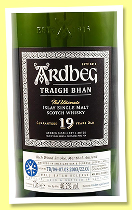
|
Ardbeg 19 yo 'Traigh Bhan Batch 4' (46.2%, OB, American oak & oloroso, batch #TB/04-07.03.2003/22.CG, 2022) 
We’re just filling a gap here, since we’ve already tasted all the other ‘Traigh Bhan’ up to this year’s batch 6. These are mid-aged Ardbegs that are fairly ‘gentle’. Colour: pale gold. Nose: a soft Ardbeg, very lovely, rounded by the American oak, with custard, cappuccino, hazelnuts, two small oysters, old tweed worn smooth by countless rains and storms, fireplace and cigarette ashes, then bruised apples and a touch of tar. It’s very pretty, clean, pure, almost gentle. Mouth: this is frankly very good. Beautiful bitterness over ashes, more bruised apples, smoked almonds, and then even more ashes. You’d think they added ashes from an old kiln – they may have kept some. A few drops of seawater. Finish: long, taut, with lovely bitterness and always those ashes. Comments: I can’t help but feel, even without all the batches in front of me, that this is slightly superior to some others. Or maybe it’s the Christmas spirit getting to me… I even find certain elements of the famous LOTI (aka Lord of The Isles).
SGP:557 - 90 points. |
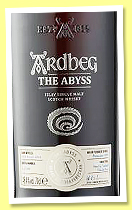
|
Ardbeg 34 yo 1989/2024 ‘The Abyss’ (48.4%, OB, heavily toasted French oak, 400 bottles) 
€25,000 and said to stem from the three (or two?) remaining casks of the first Corryvreckan. I tried the latter (the Committee Reserve) as it came out in 2008, so sixteen years ago, it was superb indeed (WF 92). From this, we can deduce that this first Corryvreckan NAS was actually an 18-year-old, since 34-(2024-2008) =18, right? This lines up with the 1989 vintage attributed to The Abyss in the brand’s communications, though it’s still surprising that Ardbeg chose, at the time, to release the first ‘Corry’ as a NAS instead of proudly displaying its slightly impressive age of eighteen years or even its vintage. After all, 1989 was the year Ardbeg was partially reopened under Allied’s ownership, led by the Laphroaig team, after about a decade of total closure. Doom and gloom. I don’t even remember whether the purifier was running back then (S., who cares!). So, this is a very significant vintage for Ardbeg, although we’ve never, for our part, tasted an Ardbeg 1989 among the over 500 different versions we’ve tried, except for the ‘Mandibolari,’ whose authenticity is highly contested. But no matter; after all this rather pointless rambling, let’s taste this little ‘Abyss’… Colour: walnut stain/bronze. An unusual colour, which might explain why these casks weren’t selected back in the day for the first Corryvreckan. Nose: … but the nose is very beautiful, fairly delicate, evoking pine bud liqueur, figs, peach or cherry leaves, dried mint, then old glue and varnish, preserved greengages, an old toolbox, a touch of saltpetre, an old copper kettle, then embrocations, ointments, tiger balm, patchouli… Ultimately, it’s the greengages that dominate. All this is delicate, polished by time, slightly fragile, and quite… romantic. I can’t help but wonder if one or all of the casks had been patched. Mouth: you completely get those fruit tree leaves again, cherry stalk tea, a kind of mentholated tar, old herbal liqueurs, leather, very old cognac, resinous wood, pipe tobacco, pre-war crème de menthe… In fact, it’s like a slightly faded pre-war cognac, the sort we sip from time to time on a Sunday. Perhaps the French oak has done much of the heavy lifting here. There’s a little sandalwood too, though the structure remains pretty light. Finish: short, almost evanescent but quite bitter and earthy. Underberg. Comments: I think its time has come, and the casks have taken over, at least on the palate. But it remains an emotional old thing, of course. And the packaging and stories are, naturally, totally flabbergasting. Though perhaps the name ‘Abyss’ was ever so slightly… prophetic. Love Ardbeg, Ardbeg forever!
SGP:373 - 83 points. |
| |
December 18, 2024 |
|
  |
American Whiskies, Part Two
Wow, that Old Potrero we enjoyed last time was something special! We’re delighted to be having more today. In fact, it turns out there’s far more American whisky in the library than we realised, including a good selection of ryes. |
|
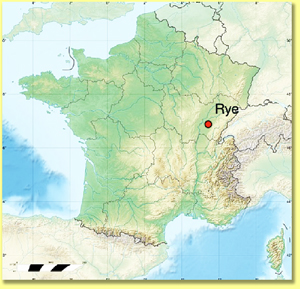
It's not that it's particularly important, but there is
indeed, a small village called Rye in France's Jura,
located between Dole and Lons-le-Saunier.
Perhaps is it a sign, Rye is not that far from WF HQ. |
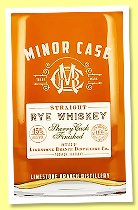
|
Minor Case (45%, OB, Limestone Branch Distillery Co. Straight Rye Whiskey, +/-2023) 
Very strangely, this rye was finished in cream sherry for 6 months after 2 years of regular ageing. It’s supposed to “replicate the pre-prohibition style” of the Beam family, but did they really use to finish their bourbons and ryes in cream sherry before prohibition? I’ll add that this is sourced whiskey, no doubt from MGP in Indiana. So, it’s another non-distilling distillery we’re dealing with here. Let’s move on… Colour: gold. Nose: orange cake, maple syrup, caramel, quite fresh and curiously light. The sherry speeds up the feeling of ageing. Mouth: this is a light rye, probably not 100% or 95% rye. Cinnamon, sawdust, a little green pepper, a touch of bitter orange, and some very ripe grape juice, which you wouldn’t normally find in sherry, but I think it’s good, just rather simple. Finish: the sawdust and cinnamon stand out more, with also a very slight sweet-salty note. Aftertaste a little drying. Comments: nice, but the sherry doesn’t make too much of a mark and as a result, it feels very young. Not much ryeness either.
SGP:551 - 80 points. |
We were talking about MGP and Indiana... |
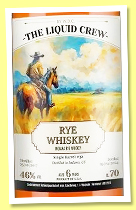
|
Indiana Rye 6 yo 2017/2024 (46%, The Liquid Crew by W.D.C., mashbill 95% rye, cask #32, 294 bottles) 
A single barrel of that very famous MGP ‘95% rye’ that’s been feeding so many brands (because it’s good!) Colour: gold. Nose: another world, much fresher and drier, while being spicier and breadier. And more to our liking, no need to say. Bits of metal, banana skins, rye bread, violet sweets, plenty of thyme and rosemary, pine needles, and a drop of tequila… Mouth: sweeter but also spicier, so actually bigger, with quite a lot of pink pepper upfront, then green oranges, lavender sweets, that tiny shot of tequila, fir buds, and citron liqueur. All of that works in sync, while the bready part also joins in. Finish: good length, mainly on oranges and a little ginger cream. The rye bread comes back in the aftertaste (something Swedish, no?) along with a bit of juniper. Comments: it’s excellent while the strength is just perfect.
SGP:661 - 87 points. |
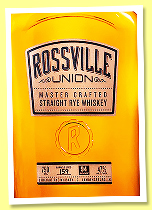
|
Rossville ‘Master Crafted Union Rye’ (47%, OB, Straight Rye, +/-2023) 
A vatting of 159 barrels blending both MGP’s ‘95% rye’ mashbill and their ‘51% rye’ one. Colour: gold. Nose: it feels a little young but very nice, on bananas, dried flowers, and a few books (paper and cardboard). A bit of peppermint but not much rye, not even bread. It’s a little odd in that sense, but it’s pretty. Orange peel. Mouth: it’s very good, very direct, rather simple. Orange juice and honey with some pepper and juniper. Still that slightly cardboard-like note in the background. Finish: fairly long, fruitier, dominated by oranges and prickly pears. The aftertaste is again more peppery and a bit cardboardy (or on sawdust). Liquorice. Comments: actually, it’s very good, but it suffers a little after the ‘Liquid Crew’, which had far more to tell us.
SGP:651 - 83 points. |
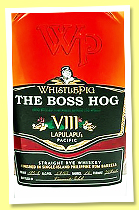
|
Whistlepig ‘The Boss Hog VIII’ (52.4%, OB, LapuLapu’s Pacific, straight rye whiskey, cask #95, 2023) 
€550 and a finishing in a Philippine rum barrel – not very coherent, is it? If it’s Don Papa, it’s like replacing a Ferrari’s engine with a small Hyundai (nothing against Hyundai, of course). If it’s Luisita, that’s much better, but sadly, we don’t have that info! In any case, what an idea… Now we just need to know if the rye here is American or Canadian. Colour: full gold. Nose: very soft, inoffensive, fairly elegant, without obvious ‘Don Papa’ notes, more on honey and a tiny roasted Brussels sprout drizzled with honey. Then more and more candied cherries, heaps of candied cherries. With water: the rye side remains very discreet, don’t expect to find even a hint of rye bread. Mouth (neat): the candied cherries hit straight away, followed by banana cream and orange liqueur mixed with Timut pepper and liquid caramel. If it’s Don Papa, this is the best possible use for Don Papa (domestic uses are impossible because it would clog up everything). With water: fruitier with a certain balance. The rye now appears, lavender, poppy seeds, juniper, pumpernickel, lavender… Finish: not very long but lovely, perhaps its best phase, despite the slightly stifling sweetness. Cinnamon liqueur. Comments: much better than I feared, but you have to like sweetness.
SGP:751 - 85 points. |
While we're on the topic of the unusual... |
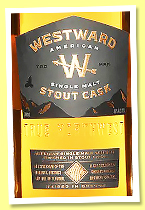
|
Westward ‘Stout Cask’ (46%, OB, single malt, +/-2023) 
Empty casks are handed over to friendly Oregon brewers, then filled with Westward malt. A variation that can work – we’ve tasted fun things of this kind in Switzerland with Säntis, but many distilleries have jumped on the bandwagon as everyone tries to expand their ranges. Colour: deep gold. Nose: a LOL-malt, something I really enjoy because ‘it gives you a break’ when you’re tasting a lot. Huge notes of dark chocolate, then aubergines and artichokes, baker’s yeast, roasted malt, and very dark honey. I really like this little monster on the nose, I must admit. Mouth: this works very well, I’m afraid. Still that dark honey (chestnut and manuka, 50/50) and chocolate, along with a very yeasty side I really enjoy and all kinds of roasted nuts – pecans, peanuts, Brazil nuts, almonds… Finish: long, on similar notes with oranges now taking control. Comments: it had been months since I dared to taste this baby, I was procrastinating. One should never procrastinate.
SGP:661 - 87 points. |

|
Wyoming Whiskey ‘National Parks No.5’ (52.5%, OB, straight bourbon whiskey, barrel proof, 2024) 
I think this is brand new, from Kirby, Wyoming. Nothing to do, I think, with the old ‘Kirby’ whisky brand. This is the first time we’re tasting a ‘Wyoming Whiskey’, and I’ve just seen that it belongs to Edrington (HP, Macallan). There seems to have been quite a bit of brand consolidation in recent years, with diversification efforts popping up all over the place, well it seems. Colour: full gold. Nose: how lovely this is, with the softness of corn but also that very pretty earthy side from the rest of the mashbill. Notes of ‘Belgian’ mandarin liqueur, fresh mushrooms, honeysuckle, a bit of lilac, acacia honey, a touch of cane syrup and agave, then a very pretty hint of parsley… Yes, everything here is very pretty. With water: touches of potting soil and apple peelings. Mouth (neat): soft, slightly sweet, it doesn’t seem to have much rye. The texture is quite light, heading towards roasted hazelnuts and very sweet English tea (not that I’m saying our friends over-sweeten their tea, mind you). With water: it retains a light and sweet backbone, but without any obvious fragility. Finish: a little short. Nougat and cane sugar. Comments: soft and even light, but without any excessive weakness. Must be the corn.
SGP:630 - 84 points. |
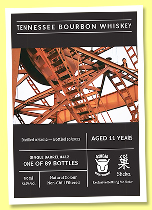
|
Tennessee Bourbon Whiskey 11yo 2012/2023 (52.9%, Oxhead Whisky Company & Shelter, barrel, cask #412, 89 bottles) 
This should be G. Dickel. Colour: deep gold. Nose: there’s a bit of that typical pineapple from JD (and GD), then a medicinal side reminiscent of Laph (really?), which is very surprising. There’s also a little note of white nougat flavoured with mint – unusual but very pleasant. With water: seawater and inhalation essences. Incredible. Mouth (neat): surprisingly robust, almost Scottish, almost peaty, marked by white fruits, cumin, earth, seaweed… All of this is extremely improbable but very good. With water: and yet, the base is clearly that of a bourbon, with vanilla-coconut and varnish-orange liqueur notes. Finish: similar. Touches of tar. Comments: very surprising, very excellent. As long as there are mysteries like this in our whiskies, all will be well. I know what you’re thinking – I’ll clarify that this baby was fully aged in the USA.
SGP:653 - 88 points. |
Hang on, we're going to check something... |
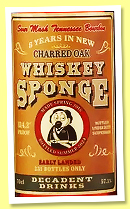
|
Tennessee Sour Mash Bourbon 8 yo 2016/2024 (57.1%, Whiskey Sponge, Decadent Drinks) 
Definitely George Dickel, aged 3 years in the US and 5 years in Scotland. 75% maize, 21% rye, 4% malt and 100% fun. Colour: full gold. Nose: it’s almost like Grand Marnier aged in wood (Cuvée du Centenaire), with sandalwood, incense, patchouli, and a packet of bidis. You’d almost put Joan Baez on the stereo, if it weren’t for the gingerbread notes that appear next (why that?). With water: that typical earthy side now comes through. A touch of tobacco. Mouth (neat): not a gram of peat, but a lovely combination of honey, maple syrup, woodruff, cognac, juniper, and cloves. It remains soft overall, with the orange liqueur leading this charming little herd. With water: it’s truly excellent, though the structure stays a bit light. Virtually no malt, you see. Finish: of medium length, gentle, but a touch of star anise sneaks in among the citrus notes. Comments: top of the basket.
SGP:651 - 88 points. |
Sour mash? Just ask... By the way, in case you’re new, sour mash isn’t actually 'sour'. |
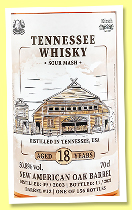
|
Tennessee Sour Mash 18 yo 2003/2021 (50.8%, Wu Dram Clan & Kirsch Import, single barrel, cask #12, 156 bottles) 
This could only be George Dickel, and of a beautiful age, no less. Colour: full gold. Nose: a perfect demonstration of time’s effect, as the base is strictly identical to the Sponge’s, except it’s rounded out, with myriads of small citrus fruits this time, and less of the bidi side. In other words, the ten extra years have reduced the impact of the wood (not the other way around) and broken down the incense and gingerbread notes into countless micro-aromas from the same universe. What we call here a ‘fractal’ evolution. With water: sublime blood oranges. Mouth (neat): closer to the 8-year-old, rawer, on honey, maple syrup, and spices. With water: oh, it’s beautiful, on caraway, old Cuban aguardiente, and even a touch of old cachaça. I swear. Finish: long, with magnificent spices and mead fit for the Greek gods – well yes, that’s what they were drinking on Mount Olympus. Comments: same very high level as the Sponge, with ten extra years. Do ten years deserve two more points? Of course they do.
SGP:651 - 90 points. |
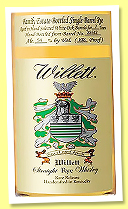
|
Willett 7 yo ‘Family Estate Rye’ (54%, OB, for LMDW, Straight Rye Whiskey, Single Barrel, cask #22612, 2024) 
74% rye in here, that’s going to be a change. Colour: full gold. Nose: the rise in power of the ‘new’ Willett. We find complexity, precious breads, citrus fruits, soft lavender, that ‘almost’ soapy side, juniper, coriander, Thai basil, mustard seed bread… Such complexity if you take the time to listen. With water: a touch of papier-mâché, otherwise the same, and all the better for it. Mouth (neat): by Zeus! Melon, peaches, citron, olive oil, and heather honey. It’s masterful, I’m afraid. With water: again, unchanged, the water adds nothing but a few sultanas that appear out of nowhere. Finish: long and almost thick. Candied kumquats and dried apricots. Comments: 90.49999 points, but Dura Lex, sed Lex.
SGP:641 - 90 points. |
As they say, rye is (perhaps) the future of malt. Right, one last one, then we’ll do a third and final American session next time. |
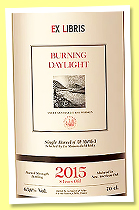
|
Old Potrero 8 yo 2015/2024 ‘Burning Daylight’ (65.6%, Ex-Libris, LMDW, rye) 
Let the Californian whisky speak. Indeed, that’s better. Colour: deep gold. Nose: it’s monstrous, it has everything. But if I had to use only three descriptors, I’d say 1. Bergamot, 2. Vineyard peach, 3. Fresh fig, and 4. (we do what we like, it’s our ‘blog’) white clover honey. Sublime nose. With water: superb woody spices. Pinecones, high-end plywood, spruce, thuja… Mouth (neat): sweet Vishnu and holy featherless crow! Imagine a rush of olives, oysters, menthol tobacco, and a triple avalanche of smaller flavours. This whisky isn’t human (no joke, S.) With water: exotic fruits roll in, mango in the lead. Curiously, it reduces the interest ever so slightly. Just a tiny bit. Finish: long, balanced, fresh, fruity, and spicy. The coriander comes back at the very, very end. Comments: we brushed against 92 points. When’s the next Air France flight to San Francisco?
SGP:751 - 91 points. |
I think that in our third and final US session (for 2024), there’ll be more Old Potrero – and plenty of Willett. See you soon. |
| |
December 17, 2024 |
|
  |
The return of American whiskies on WF
There are plenty of small distilleries doing wonderful things, and it seems, according to our excellent friends over at WhiskyCast, that the designation ‘American Single Malt’ is starting to be more regulated. Let’s see what we’ve got, in no particular order (Elon Musk doesn’t have a distillery yet, does he?). |
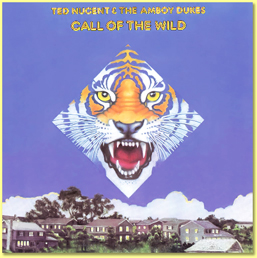 |
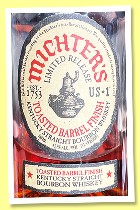
|
Michter’s ‘Toasted Barrel Finish’ (45.7%, OB, Kentucky Straight Bourbon Whiskey, batch #124H2818, 2024) 
Finished for 18 months in a toasted (not charred) barrel, so we can indeed expect a fair dose of spices. Colour: deep gold. Nose: rye upfront, gingerbread, toffee, fruit jellies, a hint of geranium, and those speculoos biscuits we often find with these finishes. I’ll admit I’m not well-versed in the use of fresh double wood, but this doesn’t seem too ‘over the top’. Mouth: the wood’s definitely doing the heavy lifting here, with sweet spices, stollen cake, dried raisins, ginger, and a faint undercurrent of bittersweet liquorice wood, which is quite typical. Very cask-driven, but we saw that coming. Finish: long and thick, full of molasses, demerara sugar, speculoos again, and yet more astronomical amounts of liquorice wood… even a touch of glue sneaking in towards the end. Comments: far from Michter’s 10 yo ‘Kentucky Straight Rye’ that I adored back in September (WF 88), but I’m sure this style has its fans.
SGP:471 - 78 points. |
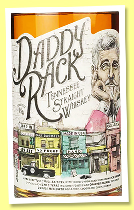
|
Daddy Rack (40%, OB, Straight Tennessee Whiskey, +/-2024) 
I believe some Scottish friends should launch a brand called ‘Doctor Dunnage’, just saying. Colour: gold. Nose: very soft and, dare I say, pleasant, with ripe gooseberries, sweet maize cream, vanilla fudge, and a touch of white chocolate. There’s even a hint of crystallised strawberries or something in that ballpark. Offending no one, which, let’s face it, is a real advantage these days. Mouth: not quite on the same level as the nose, with more wood and caramel, a few little biscuits, and that rather typical lavender and pepper combo. Light but not weak. Finish: fairly short, a bit on the sawdust, and once again, some liquorice wood. Comments: this works for me! I even think it’s got a bit more presence than some other entry-level Tennessee whiskeys we all know well (JD, GD).
SGP:551 - 78 points. |
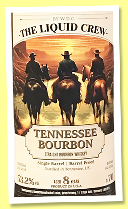
|
Tennessee Bourbon 8 yo 2016/2024 (53.2%, The Liquid Crew by W.D.C., straight bourbon whiskey) 
Colour: gold. Nose: very unusual, with scented talc, bitter oranges, a mothball or two, violet liquorice, rye bread, and pumpernickel… surprising and really lovely, I must say. With water: that cologne-like side returns, but it doesn’t feel out of place at all. There’s also Panettone, which feels very seasonal. Mouth: a mix of slightly bitter orange juice and ginger wine to start, then those breads we mentioned earlier. A touch of pencil shavings and a hint of juniper gin (all gins have juniper, no?). With water: it softens, almost becomes gentle, but holds the water beautifully. Buckwheat. Finish: medium length, on similar notes, slightly peppery with a very faintly drying aftertaste. Comments: I’m stepping a little outside my usual comfort zones here, but I really enjoy this sort of big gin aged in oak. Generally speaking, these batches are said to come from G. Dickel.
SGP:551 - 86 points. |
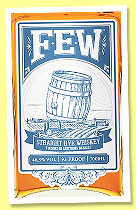
|
FEW 7 yo (46.5%, OB, Straight Rye Whiskey, Sauternes barrel finish, LMDW Foundations, 2024) 
Here’s a proper ‘Illinois bandit’. American rye in Sauternes casks, that’s quite the bold move, though Sauternes does seem to be tussling with mizunara these days (though isn’t mizunara already feeling a bit 2023?). Colour: red amber. Nose: full-on glue, wood varnish and even a bit of acetone – all aromas we’re rather fond of – then speculoos biscuits and Christmas gingerbread. Perhaps a touch of dried apricot courtesy of the Sauternes, though it’s hard to pinpoint exactly. A lovely nose that doesn’t lean too heavily on this rather improbable finish. Mouth: here the sweet, fruity side makes itself known, much more so than with a typical straight rye. Loads of apricot and mirabelle jam spread over a nice slice of rye bread, with touches of grenadine and eucalyptus sweets. Finish: long, creamy, and fruity, though it heads back towards rye bread and black pepper towards the end. Comments: this is fun, and it’s even very good, although a touch sweet for my taste. At this rate, the châteaux of Sauternais may soon end up as barrel finishers, much like those bodegas in Andalusia.
SGP:761 - 83 points. |
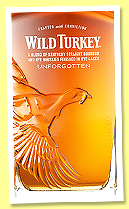
|
Wild Turkey ‘Master’s Keep Unforgotten’ (52.5%, OB, bourbon, 2022) 
A blend of Wild Turkey’s rye whiskey (8 and 9 yo) and bourbon (13 yo), finished in rye casks – which does sound like a bit much, doesn’t it? There’s quite the story behind this one, but let’s crack on… Colour: gold. Nose: very soft, all about cakes and gentle spices, then irises, broom flowers, prairie honey, and ginger cookies. Really very kind and charming. With water: even softer and more alluring, Danish pastries and touches of beeswax coming through, plus a little lavender, as is often the case. Mouth (neat): still very gentle but with a lovely structure, full of yellow fruit jams, a hint of cinnamon and ginger, some raisins, and even a bit of lemon tart (meringue included, if you please). Really quite lovely, I must say. With water: the soft spices take the lead here – cinnamon, a touch of nutmeg. Finish: medium length, with the wood starting to assert itself a little more, though still within acceptable limits. Comments: all in all, I think this is very, very good stuff.
SGP:661 - 87 points. |
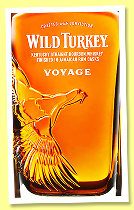
|
Wild Turkey ‘Master’s Keep Voyage’ (53%, OB, bourbon, 2023) 
Ouch, this time it’s finished in Jamaican rum casks from Appleton (Wild Turkey and Appleton both belong to Campari these days). Bourbon -> rum -> bourbon -> rum -> bourbon… could this be barrel perpetual motion? Appleton’s lovely stuff, though much softer compared to HD, WP, NY or MM, so this should slide through without much fuss. Colour: deep gold. Nose: actually drier than the Unforgotten, with notes of chocolate, burnt wood, a few tiny hints of sweet brine (ah!), and then plain old vanilla. A touch of pine bark too. With water: the rum becomes more noticeable, though without any particularly clear markers. Mouth (neat): much sweeter, almost sugary, as though they’d added cane syrup to the bourbon. Loads of orange liqueur, maple syrup, and honey… With water: still very sweet, although the spices start to rise to the surface. Finish: medium length, still quite sugary, with honey and a touch of cinnamon in the aftertaste. Comments: perhaps this would help make a lovely BBBB (baba au bourbon). I like it, but I very much prefer the Unforgotten.
SGP:751 - 82 points. |
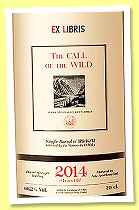
|
Old Potrero 9 yo 2014/2024 ‘The Call of the Wild’ (66.2%, Ex-Libris, LMDW, rye) 
The Call of the Wild – wasn’t that a Ted Nugent album? No, of course not, we’re talking Jack London. Either way, here we are in San Francisco with a truly ‘pioneering’ American whiskey. I remember tasting my first Old Potrero back in 2009, and back then it was still a bit like rocket fuel. Fifteen years on, I’m very curious… Colour: copper amber. Nose: incredible, absolutely nothing to do with the past, this is proper West-Coast whiskey, the Stan Getz of rye. Glorious harmony of fruits, wood, and cakes, perfectly balanced even at 66% ABV. Honey, quince, mandarin, soft mango… it’s just perfect, really. Wow. With water: majestic, grand, flawless, with tangerines taking centre stage in their full splendour. Mouth (neat): careful with this ABV – very creamy, with a faint peaty touch à la Hellyers Road and massive doses of quince paste and pinot gris. Utterly irresistible. With water: the rye takes over in the most beautiful way. The rest will remain between me and this whiskey if you don’t mind – unless you’d like to alert the Anti-Rye-o-Porn Brigade. Finish: long, very fruity, and entirely elegant, like peach liqueur from vineyard peaches. Comments: honestly, Old Potrero had slipped off my radar – sometimes I feel a bit ashamed.
SGP:751 - 91 points. |
It’s best to stop there. We’ll have plenty of other American whiskies in the coming days, including more Old Potrero, some Willet, ex-MGP, etc. See yo |
| |
December 16, 2024 |
|
  |
A few joyful blends from Scotland
Let’s see what we’ve got. For example, this famous aperitif…
|
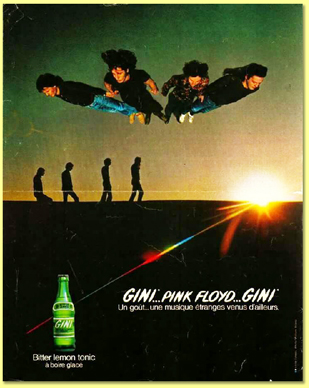 |
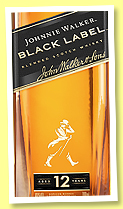
|
Johnnie Walker 12 yo 'Black Label' (40%, OB, +/-2024) 
Johnnie Walker ‘Black’ and Chivas Regal, both proudly carrying their age statements (funny that, isn’t it) are the symbols of ‘deluxe’ Scotch for most of the planet. It’s only natural that we give them a go now and again, even if the last time we tried Johnnie Black, it didn’t have much in common with what it was back in the 1960s. No age statements back then, but a stellar level (WF 91) just to say… Colour: deep gold. Nose: toasted bread, toasted oak, a bit of fresh malt, some vanilla, then a touch of cardboard and fresh sawdust, followed by a little puff of peat smoke re-emerging and hints of crushed strawberries. Mouth: you could call it peaty, but there’s also a layer of apple compote and caramel, with a faint earthy edge. The structure’s not as light as you might expect. Finish: not very long, but you get some marmalade, a bit of coconut, and a malty aftertaste that’s just a wee bit salty. Comments: it’s still at WF 78. Make no mistake, that’s a very good score for such a widely distributed blend.
SGP:362 - 78 points. |
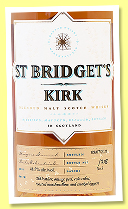
|
St Bridget’s Kirk ‘Solera Release Batch #3’ (48.5%, Hannah Whisky Merchants, blended malt, oloroso finish, 218 bottles, 2024) 
In the world of whisky, the term ‘solera’ can mean all sorts of things, from simple ‘living vats’ or ‘perpetual blends’ to proper systems with interconnected criaderas or casks, which seems to be the case here. Either way, this word always makes us long for another trip to Andalusia. Batch 2 was very good (WF 85), as was the amarone finish (yes, Serge here) … Colour: straw. Nose: a young, fruity, and cheerful malt that starts on ripe apples and brown sugar, moves through pears and gooseberries, reaches beeswax with a gentle smokiness, and then shows cherries and a few fresh biscuits. Some amaretti and a touch of fruity beer. Mouth: quite full-bodied, firmer on the palate, spicier too, smokier, with lovely pepper and those fresh fruits again, alongside a bit of wax. Hints of orange zest and a touch of ginger. Finish: rather long, on pepper and liquorice allsorts. A slightly saline, almost coastal character comes through afterwards. A faint touch of bitter sherry. Comments: this is an excellent blend, in my opinion—firm, fairly full-bodied but very well balanced.
SGP:562 - 85 points. |
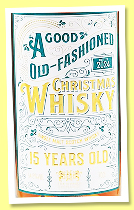
|
A Good Old-Fashioned Christmas Whisky 15 yo (54.8%, The Whisky Exchange, 2024) 
Delighted to taste this one on time for once, rather than being my usual late self—it would have been far too obvious here. Note, this is a single malt. Colour: deep gold. Nose: an avalanche of raisins, little cakes, old walnuts, becoming increasingly dry despite a hint of old grain whisky (coconut), though, of course, there’s none in here. Cloves and dark chocolate. With water: a few touches of truffles and morels, a rather indulgent fruitcake, humus, and dead leaves… This baby loves water. Mouth (neat): even better than the nose, in proper GF style, rich, slightly thick, on prunes and thyme infusion, then coffee and chocolate. With water: the prunes return, alongside cloves, cumin, and a bit of fir honey. It really does scream Christmas, indeed. Finish: long, still rich and beautifully spiced. You can’t help but think of a very Germanic mulled wine. Comments: this is excellent and truly very ‘Christmas’. Apparently, Santa’s reindeer get through quite a bit of this stuff on Christmas Eve (one needs a conclusion, after all).
SGP:661 - 87 points. |
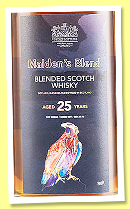
|
Maiden’s Blend 25 yo 1999/2024 (44.6%, Vintage Bottlers, blended Scotch, cask #6, 652 bottles) 
Here’s one of those ex-Edrington blends that have piqued the interest of many, most wondering if it’s really just a ‘blended Scotch’, whether there’s Macallan in it, and if so, in what proportions. I don’t think anyone has reached any definitive conclusions, and I doubt we’ll risk it this time either. Colour: gold. Nose: it’s more coastal and smokier than pure Macallan, with a rather splendid earthiness (mosses, dead leaves, wild mushrooms) and touches of grilled bacon too. Then comes a bit of tar, cigars, hints of hoisin sauce, pu-ehr tea, and bergamots… It only grows more complex over time. You get a faint whiff of old grain as well, it seems, but is there really any. A tiny touch of coconut. Mouth: a slight bourbon note to start, then dark beer, raisins, gingerbread, and a more pronounced ‘old grain’ character on the palate (coconut cappuccino, very Starbucks-esque). A little cola. Finish: fairly long, though this time it leans toward old column rum. Quality rum, of course. Comments: on the nose it feels very ‘malt’, while on the palate it’s a bit more ‘blend’. Either way, it’s excellent.
SGP:651 - 87 points. |
There are four in total, let’s try a second one... |
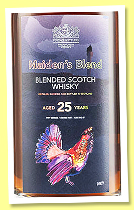
|
Maiden’s Blend 25 yo 1999/2024 (44.6%, Vintage Bottlers, blended Scotch, cask #7, 654 bottles) 
Naturally, given the size of these batches, we’re talking butts. Colour: darker gold. Nose: this time it’s more about toffee taking charge, fruitcake, chocolate, dark nougat, and a few lovely metallic touches (like an old copper kettle from granny’s kitchen). Then there’s a hint of cedarwood and old tools from the back of the garage. Mouth: it’s very close to cask #6 on the palate, any differences are minimal. The cola note comes through nicely in the end. Finish: a lovely length, on herbal teas and, once again, some very fine rum. You particularly think of a famous Bajan rum. Comments: nothing here would justify awarding a different score to this one. We remain firmly at the top of the blends.
SGP:651 - 87 points. |
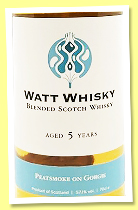
|
Peatsmoke on Gorgie 5 yo (57.1%, Watt Whisky, blended Scotch, 618 bottles) 
This is 42% 5 yo peated malt plus 58% 12 yo North British. So, 5 yo peated malt… (ha). Colour: gold. Nose: I’d swear some aspects remind us of Johnnie Black, only with more power, more knack (how does one fire himself?) You get the feeling something’s about to happen once water is added, but for now, it’s still a bit gentle. With water: burning hay and straw, sheep suet, engine grease, gravel, basalt, but also some grist. Mouth (neat): a lovely rooty side, gentian, celery, even beetroot… All wrapped up in honey and orchard fruit compotes. The peat seems to stay a little hidden, but you can feel its presence waiting in the wings… With water: here it comes—seawater, lemon, ashes, pepper, kippers, iodine… It’s incredible, the power of water on whisky. I’ve noticed a whole trend of tasting whisky without adding a single drop of water, but I find that a shame. Well, this is an excellent whisky once reduced to, let’s say, 45% vol. Roughly speaking. Finish: better and better! The malt has crushed the grain. Comments: a sketch-like whisky—now there’s something new. Fun and excellent. And possibly the best use of young grain whisky.
SGP:566 (with water) - 87 points. |
Since we’re having young ones... |
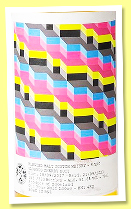
|
Blended Malt #1 2017/2023 (51.6%, Cut Your Wolf Loose, oloroso sherry butt, 333 bottles) 
Colour: white wine. Nose: some kind of waxier Islay peater, plus ripe apples and pears ‘from somewhere else’. The coastal side grows stronger over time, as does the peat. A wonderful sour cherry note, brine, anchovies, tapenade… With water: oh, how beautiful, we’re at the heart of the malt. Mouth (neat): excellent. Perfect punch, peat and lemon, plus aniseed and green apples. Nothing to throw away. With water: brined olives! But where do these olives come from? Finish: long, razor-sharp. Salty, smoky, close to the malt. Comments: it’s a bit like the cousin of the young Watt blend—very different, but in spirit, they’re close.
SGP:466 - 88 points. |
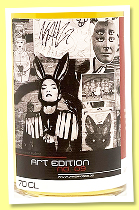
|
Taraansay Blend 14 yo 2007/2021 (58.1%, Whiskyjace, Art Edition No.9, bourbon) 
Awesome collage-y label here. Colour: white wine. Nose: light style, on vanilla, melon and coconut, plus a little hay. Perhaps not entirely living up to the grace of the label for now. With water: it becomes very gentle and reminds me a bit of Black Barrel, that not-so-successful experiment (unlike the rest) from William Grant. Mouth (neat): the grain takes the lead here, there doesn’t seem to be much malt in sight. Coconut liqueur and quite a bit of ethanol and wood. With water: much better, it becomes creamier, sweeter and softer. Corn and vanilla sugar. Finish: a touch of lemon brightens things up a bit. Comments: we’ve tasted things ten thousand times better from Whiskyjace, but I’ll admit the label is sublime. Still, this remains decent enough, honestly…
SGP:630 - 75 points. |
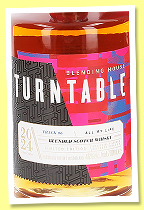
|
Turntable 'Track #6 – All My Life’ (46%, Turntable Spirits, blended Scotch, 2024) 
This is Balblair, Benriach, Glenallachie, Knockdhu and North British in ex-bourbon, Limousin and oloroso wood. Very Rolling Stones indeed (you say All My Life is by the Beatles? What Foo Fighters?) Colour: gold. Nose: just an upper blend. Good sweet and fruity malts, shortbread, vanilla, butterscotch and scones. We’ll have a double espresso, please. Mouth: same impression, ripe fruits, pear cake, soft malt, all sorts of cakes, banana bread, a touch of honey, a little orange… Finish: fairly long, as balanced as… let’s say, Simone Biles on the uneven bars. Coffee cream and maple syrup. Comments: a sense of ‘middle ground’ and perfect balance. The little North British doesn’t have much to say in this affair.
SGP:551 - 85 points. |
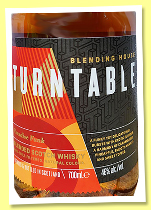
|
Turntable ‘Paradise Funk’ (46%, Turntable Spirits, blended Scotch, 2023) 
Another bold mix of distilleries and casks, it seems we’ve got Benrinnes, Blair Athol, Invergordon, Knockdhu, North British, and a ‘secret’ Speyside (secret = who cares, really). Anyway, nothing funky in here, no Islay, no Jamaican. As for the paradise, we’ll see about that… Colour: gold. Nose: funky? It’s more like chamber music. Vanilla, melon, apple, barley, and buttered pancakes. Mouth: much better on the palate but still very malt-forward, with not much funk. It suffers a bit in comparison with the Foo Fighters, even if it’s perfectly decent now. Finish: not very long, with a fairly light texture dominated by sweet grains. A slightly earthier and even medicinal note appears in the aftertaste, but it’s a bit late. Comments: extremely correct, but it lacks a clear direction and, frankly, any funk. In short, it’s neither Kool & The Gang nor Parliament (nor our dear Average White Band).
SGP:641 - 79 points. |
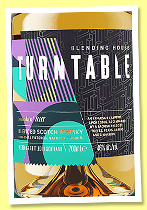
|
Turntable ‘Smokin’ Riff’ (46%, Turntable Spirits, blended Scotch, 2023) 
Tell me this is peated… Right, there’s Caol Ila, Craigellachie, Knockdhu and North British. Let’s quickly see what North British’s maize can do against Caol Ila. We’re not even looking at cask types. Colour: amber gold (eh?). Nose: well, of course—engine oil, oyster shells, dried seaweed, ashes of all kinds, a box of cigars and a beach campfire. Mouth: well played! The proportions work brilliantly, with dark honey (strong in flavour), toasted brioche, touches of liquorice, mint and tar, and a bit of grapefruit sneaking in, a small gherkin, an oyster, a little green pepper, and a caper… Finish: more of the same for quite a while. Comments: one day we’ll need to build a monument to Caol Ila’s glory. Superb, this peated blend, with a riff worthy of Jimmy Page. Right, let’s spin Achilles Last Stand… I know, John Bonham…
SGP:565 - 87 points. |
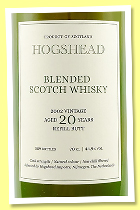
|
Blended Scotch 20 yo 2002/2023 (44.9%, Hogshead Imports, refill butt, 589 bottles) 
Sometimes it’s nice not to know what’s inside—it feels like a holiday (ha). Colour: gold. Nose: very malty, also very much on dry sherry, coffee, tobacco, nuts, then mint, white chocolate, hazelnut halva, and coconut… Ah, that must be the grain, which gradually takes more and more importance over the malt. Phase in, phase out. Mouth: the grain takes the lead immediately this time. Frappuccino, vanilla cream, toasted macadamia nuts, coconut balls, and white chocolate. A few small bits of candied orange zest help consolidate the texture. Finish: of medium length, with that rum-like note we’ve found in a few others. Comments: it loses a bit of steam over time, but it’s still a very good blend. That said, I preferred their excellent 18 yo 2005 from a few months ago (WF 85).
SGP:541 - 83 points. |
A last one and after ‘Hogshead’, ‘Oxhead’… |
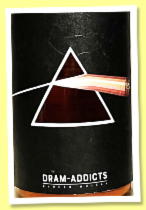
|
Blended Scotch 26 yo (44.9%, Oxhead Whisky Company, Dram-Addicts, sherry butt, cask #117359, 2024) 
As I understand it, this contains Bunnahabhain, Glenlivet, Glenrothes, Highland Park, Macallan, Invergordon and North British. Surprised there’s Glenlivet. 70% malt, 30% grain, excusez du peu. The label, meanwhile, remains very rock and roll—definitely a bit ‘Pink Floyd’. Let’s head to the dark side… I still remember the band driving past our house in their open Cadillac, escorted by the Hells Angels on Harleys (51 years ago, for heaven’s sake! Feels like yesterday…) But why am I telling you this?... Colour: red amber. Nose: very gentle and, above all, admirably compact, on madeleines and nougat. There are loads of micro-aromas behind all that, but I’ll stick to the madeleines and nougat. Mouth: oh! The molecules let loose—hints of metal, tobacco, bay leaf, a variety of honeys, oils, essences, roasted nuts, cakes and biscuits, cane sugar, praline and toffee, toasted wood, cold coffee, chicory… Not everything is perfect, but the complexity of this blend—very “Edringtonian”—makes it almost “Ellingtonian” (S., you’re fired). Finish: medium length. The grains come through a little more (aroma but without much texture), but it’s too late, we’ve already made up our mind. Comments: many of these old blends end up in Asia—here in Singapore—proof, if ever needed, that our friends have excellent taste.
SGP:650 - 89 points. |
It had been a long time since we had tasted so much blended Scotch whisky. |
| |
December 15, 2024 |
|
  |

|
|
A word of caution
Let me please remind you that my humble assessments of any spirits are done from the point of view of a malt whisky enthusiast who, what's more, is aboslutely not an expert in rum, brandy, tequila, vodka, gin or any other spirits. Thank you – and peace! |
Rums are
back on WF
The somewhat artificial, even absurd, trend of "premiumisation" that has affected many single malt whiskies in recent years has led quite a few aficionados to partially shift their attention towards rums. True, the tide has been ebbing for a year or two now, but rum’s customer base has nonetheless expanded. There’s inevitably a ratchet effect—perhaps small, but in my opinion, real. In short, we’re probably not all going to abandon rum just because the prices of single malt whisky are tumbling again, sometimes as rapidly as a lorry with no brakes careering down the Andes (what?). Anyway, let’s see what we have in store today… |
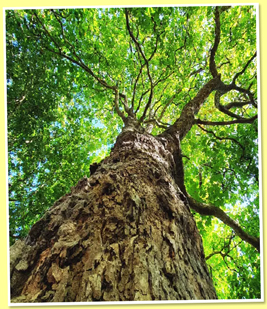
The inevitable mizunara.
You can also buy it here. |
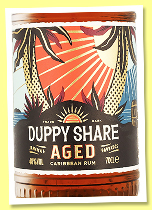
|
The Duppy Share ‘Aged Caribbean Rum’ (40%, OB, Jamaica & Barbados, +/-2024) 
A serious aperitif, for once, in the form of a lovely bottle, a blend of young rums from Worthy Park and Foursquare, offered at a very well-considered price. Colour: gold. Nose: I find you can clearly sense both origins, with diesel oil and tar on one side, and orange cake and sugarcane on the other. Those two or three little olives could come from either camp. Very pleasant, though slightly light on the nose, likely due to the ABV, which shouldn’t intimidate anyone. Mouth: it’s good and very consistent with the nose. A little sugar (without sweetness, if you know what I mean) and plenty of liquorice, brine, pineapple, papaya, and ultra-ripe bananas. Even more than ripe, really. Finish: a bit too short for the enthusiast, though the profile remains pleasant. Comments: a very nice blend where neither distillery truly dominates. A bit more punch would do it good.
SGP:542 - 80 points. |
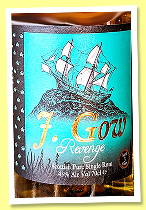
|
J. Gow 3 yo ‘Revenge’ (43%, OB, Scotland, bourbon, +/-2024) 
Rum from Orkney, hooray! Alas, the phrase ‘inspired by pirates’ on the label is a bit alarming – as bad as the Vikings – but that’s not what matters. Besides, is there a single rum on this planet that doesn’t mention pirates? They’ve been making rum at J. Gow since 2017, and of course, given the sugarcane harvests on Orkney are what they are, molasses must be imported. But it’s pot still! Colour: white wine. Nose: in the Jamaican style, with just the right amount of ‘funk’, tar, seawater, salmiak, then a light descent into softer, almost floral aromas. A touch of heather, or are we dreaming? Mouth: delightfully saline, we might even say insular. Lovely salted liquorice, seawater, oysters, pepper… Still that funk – one might even think of the Average White Band, that great Scottish funk band. Finish: lovely but a bit short. Similar aromas. Comments: in reality, this rum is produced on the tiny island of Lamb Holm in the Orkneys. I think there’s plenty of scope for a version at 50 or 57% ABV. In other words, at ‘pirate strength’. But truly, after the rums from Islay and Ninefold, Scottish rums are on a roll.
SGP:453 - 84 points. |
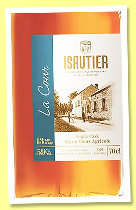
|
Isautier 13 yo 2009 ‘La Cour’ (59%, OB, La Réunion, agricole, 2024) 
An old distillery that was rebuilt and then renovated. We’ve already tasted some excellent ones. Colour: dark gold. Nose: lots of orange zest and cumin, quite an unusual combination that works very well. A slight cologne-like note, but not at all off-putting in this context—quite the opposite. Very nice earthy tones and plenty of spices. With water: not much development, just a touch gentler. Very nice. Mouth (neat): very powerful, still spicy, with cumin and caraway taking the lead, alongside orange marmalade. A bit rough, but that’s the alcohol. Mustard seed. With water: the sweetness of orange liqueur, candied ginger, and mild mustard… Fresh oak is a little noticeable, but it works, becoming even spicier. Finish: long, with a return of earthy notes and a beautiful honey that takes over. Comments: I feel that Isautier keeps improving, at least when it comes to these high-end bottlings. Very lovely spices.
SGP:561 - 87 points. |
Let’s stay in the Indian Ocean… |
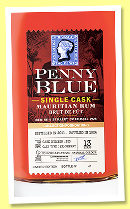
|
Penny Blue 13 yo 2011/2024 (60%, OB, Mauritius, Foundations, oloroso sherry, cask #220, 126 bottles) 
It’s Berry Bros. who develop the Penny Blue brand, which is always a rather good sign, of course. The sherry? We’ll see… Colour: caramel. Nose: an entire lorry full of Mars bars, plus a touch of instant coffee, slightly burnt walnut cake, and toffee. It’s better than it sounds in these notes. With water: let’s name the brand, Nescafé, along with a wee slice of Dundee orange marmalade (of course). Mouth (neat): a fairly light distillate wrapped in a very powerful shell, so lots of substance around the edges but a somewhat fragile middle—not necessarily a flaw, mind you. Anyway, it’s very cask-driven (clearer now, isn’t it?). With water: it’s good, more balanced, and oddly enough offers a better texture. Finish: medium length, mostly on pepper and marmalade. Comments: very good, but it suffers a bit after the Isautier, which has much more personality.
SGP:631 - 83 points. |
Since we're in the area... |
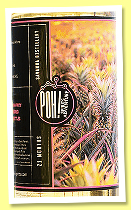
|
Savanna 21 mo (58.2%, Poh ! Spirits, La Réunion, 140 bottles, 2024) 
A blend of traditional and grand arôme, aged 21 months in Sauternes. In any case, Savanna resists everything (wink). Colour: pale white wine. Nose: the alcohol comes through a bit, but mercurochrome, varnish, brine, and diesel quickly take over, while ripe banana and mirabelles bring in some fruit. There’s also a slight finger biscuit note. Lovely. With water: the yeasty notes come to the forefront, to our great delight. You might even find a hint of peated beer. Mouth (neat): no one can resist the grand arôme, though three litres of mirabelle and apricot eau-de-vie soon come crashing through, Mad Max-style. But it’s one of the prettiest clashes imaginable. Apricots and olives? Who’d have thought. With water: what’s funny is you can’t quite tell where the flavours come from—the rum or the wine—it’s a bit of a guessing game, but the result is wonderfully coherent. It’s excellent, really, with some blood orange rising to the surface. Finish: long, with small touches of rose liqueur. The worst part? It’s actually absolutely delicious. Comments: it’s not so much how they made this that’s fascinating, but how they came up with the idea. And the fact they avoided the potential trap of grand arôme + heavy Sauternes.
SGP:752 - 89 points. |

|
New Yarmouth 19 yo 2005/2024 (55.8%, Vagabond Spirits, Silva Collection, Jamaica, maple wood finish) 
A 4-month finishing in maple wood. Surely a hit in Quebec, but I’m not convinced it could influence a New Yarmouth that much, fully loaded with all its attributes. Let’s see… Colour: light gold. Nose: tabernak, this is pure Jamaican so far—tar, carbon, acetone, rotting fruits, brine, olives, salty liquorice… With water: tarmac after a heavy tropical downpour. Mouth (neat): salty and lemony liquorice in abundance. Maybe that lemony side—and those touches of limoncello—comes partly from the maple wood, though I couldn’t say for sure. With water: I’m giving up the search here; at most, I’d say there’s perhaps a faint hint of added sweetness. Does dried maple wood contain much ‘sugary’ sap like the syrup? Finish: long, and indeed relatively soft for a New Yarmouth. Comments: it’s fun and very good. Almost makes you want to listen to Céline, though we’d rather go with Diane or Nanette.
SGP:752 - 87 points. |
Let’s carry on with something more ‘normal’ if you don’t mind. Well, we’ll try at least… |
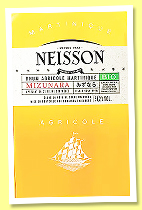
|
Neisson ‘ESB Mizunara’ (51.2%, OB, Martinique, agricole, organic, 2024) 
You’re kidding—Neisson is doing Mizunara now? Everyone says it’s ‘a rare Japanese oak,’ but at this rate, there’ll soon be no trees left standing. Seriously, it’s a type of Quercus mongolica and is, according to Wikipedia, ‘widely distributed in Northeast Asia.’ Of course, bringing it to Martinique probably isn’t great for the carbon footprint, but let’s not nit-pick. At least there’s the Panama Canal. Colour: straw. Nose: well, it’s lovely—lightly toasted and honeyed, with limoncello cakes and a faint touch of fir buds. Pleasant. With water: similar, but now more cedar wood, and even a touch of charcoal. Mouth (neat): very soft, with a slight tequila edge (from the Mizunara?) and loads of fir honeydew. A bit of caraway and poppy seeds, plus some lemon. It’s really good, though it’s starting to feel a bit like some spiced-up white rum. With water: same, with added salty touches. Lemon blossom honey and seawater, though the proportions are still unclear. Finish: fairly long, but the flavours start to feel a bit tiring—there’s a persistent sweetness that won’t let go. Comments: it’s good, very good—it’s Neisson, after all—but to me, this feels like a rather anecdotal cuvée. Next, amburana, I suppose.
SGP:641 - 80 points. |

|
HD 8 yo 2016/2024 (59.2%, The Whisky Jury, Jamaica, refill barrel, cask #101301, 269 bottles) 
A ‘multimark’ HD. We have no reason to think this isn’t Hampden, though whether it leans more OWH or <DOK remains to be seen. Colour: gold. Nose: quite gentle, with even whiffs of canned peaches over the earthy side. A lighter style. With water: new fabric, gravel, but not much varnish, glue, acetone, or ammonia… (we get it, S.). Mouth (neat): very good, with plenty of salty citrus. Preserved lemons, Italian-style, and pickles in brine. With water: the salinity comes out even more, while the texture remains fairly light for an HD. Finish: long, carried by pepper and those unmistakable preserved lemons. A touch of molasses too. Comments: there’s simply no such thing as a bad HD, and we’ve known that for ages.
SGP:651 - 86 points. |
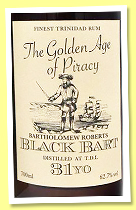
|
TDL 31 yo 1991/2023 (62.7%, Distilia, The Golden Age of Piracy, Trinidad, cask #R2455, 205 bottles) 
A tribute to ‘Black Bart,’ a famous pirate. Pirates, again! This one spent 15 years in Trinidad (and Tobago—we always forget Tobago). Colour: gold. Nose: this isn’t one of those fruity bombs we love so much (aka the Bushmills from the Caribbean), but rather a fairly earthy and mentholated rum, not hugely expressive at this stage. At 62%, that’s pretty normal—it’s probably a bit locked up. With water: hints of new tyres, but still struggling to come out. No fruit, even with water. Mouth (neat): seems very good, but it doesn’t really feel like it’s 31 years old. It also feels like the cask had a strong influence on the distillate, with a very prominent ‘resinous’ side. It’s kind of circling around turpentine territory. With water: much better, almost a resurrection, but let’s not get carried away—there are many rums at a higher level within Distilia. Finish: long, but still with that odd sweet rubber feeling. Comments: we’ve finally found a rum from Distilia that we don’t totally love… About time, really.
SGP:661 - 79 points. |
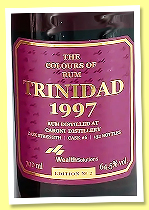
|
Caroni 25 yo 1997/2022 (64.5%, The Colours of Rum, Trinidad, cask #6, 132 bottles) 
It was about time we tasted this baby that will probably blow our heads off. Colour: gold. Nose: this is a lighter Caroni in terms of aromas, but of course, it’s powerful when it comes to ethanol. Perhaps the two are connected, aren’t they… With water: oh, how I love those new plastic notes from Temu, Wish, or Aliexpress. Seriously, I adore them—I could order useless electronic gadgets that don’t work at all just to catch that smell when you open the parcel. But let’s not talk about phthalates and bisphenol in our tasting notes (too late, S.). Mouth (neat): quite superb, though very simple at this strength. Bitter oranges, varnish, and a touch of tar. With water: lovely, rather balanced, not really a rubber bomb, but I enjoy it a lot even if it’s perhaps not a Caroni ‘+++’. Finish: long. Paint, rubber, and some budget orange liqueur. Comments: that industrial vibe—whatever that truly means—always appeals to me, even if this isn’t one of the extreme Caronis. Still, it’s very, very good.
SGP:563 - 88 points. |
Let’s head back to Jamaica to finish off… |
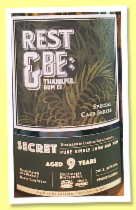
|
Secret Jamaica 9 yo 2015/2024 (50%, Rest & Be Thankful for Wu Dram Clan & Kirsch Import, 2 barrels) 
Well, they say it’s secret, but they add that it’s from a distillery in Lluidas Vale, where, as everyone knows, there are 137 distilleries. Of course, there’s only one: Worthy Park. Clever move to release these semi-secret versions. We love Worthy Park. Colour: light gold. Nose: rubber and brine upfront, then fresh branches, fresh almonds, hints of asparagus, new motor oil, and greenhouse vibes… It’s stunning, very elegant. With water: delightful, with carbon paper, thermal paper, and low-tide seawater. Mouth (neat): how good is this! There’s even a touch of Ardbeg (seriously), lemon, seaweed, shells, fresh tar, and a bit of seawater. Still to decide whether this water is from the Irish Sea or the Caribbean. With water: now just perfect. Bitter almonds, orgeat, salted lemon (no issues there), and even a hint of peat. Yep. Finish: long, fresh, salty, maritime. Comments: let me puff up my chest a bit here—it’s crucial to nail your dilution perfectly to hit 90, as we just did. With reducing water quantity and quality really matter, yep.
SGP:453 - 90 points. |
Well, since we’re at WP (theoretically)... |
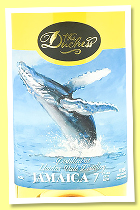
|
Lluidas Vale 7 yo 2015/2024 (63.1%, The Duchess, Jamaica, cask #18, 243 bottles) 
240–360g ester/HLPA here (marque WPH), which is relatively light, though not too light. Indeed, it’s WP. Let me say it again—brands that block independents from using their names are shooting themselves in the foot, slowly fading out of relevance among aficionados. This has already happened with many malt whiskies that younger enthusiasts don’t even know about (yes, there are young malt whisky enthusiasts!), and it would be a shame if rum brands followed the same path. Just my humble opinion: no visibility, no image. Colour: white wine. Nose: the purity at Lluidas Vale is always rather striking (no brand names allowed, right). Here we’re deep into industrial harbour water, tar, fresh oysters, and green olives—two olives, no more. With water: carbon paper, wax paper, wallpaper glue… Mouth (neat): this Lluidas Vale is so good! Even at 63%. Full of ashes, lime, liquorice wood, more ashes, and a touch of mint oil… With water: incredible purity, fruity salinity, precise aromas—olives, anchovies, asparagus, lemon… Finish: long but quite soft, precise, almost refreshing, almost like a dry martini with Noilly Prat. The London experts will get it. A faint hint of strawberry cream at the very end—some peculiar molecule at play here. Comments: I’ve always been a big fan of Lluidas Vale—bring on the next Lluidas Vale!
SGP:463 - 90 points. |
 Check the index of all rums we've tasted so far Check the index of all rums we've tasted so far
|
|
|
| |
|
|
| |
Best spirits Serge tried those weeks, 90+ points only
Ardbeg 19 yo 'Traigh Bhan Batch 4' (46.2%, OB, American oak & oloroso, batch #TB/04-07.03.2003/22.CG, 2022)
Ardbeg 2008/2024 (55%, Royal Mile Whiskies, sherry butt, cask #5078, 614 bottles)
Ardbeg 15 yo 2008/2024 (57.7%, Murray McDavid, Mission Gold, for WuDramClan, oloroso sherry octave finish, cask # 2310048, 93 bottles)
Brora 45 yo 1978/2023 (49.4%, OB, Casks of Distinction, cask #P5V2, 255 bottles, 2024)
Bunnahabhain 35 yo 1966/2002 (46.1%, OB, Feis Ile 2002, sherry, cask #4379, 401 bottles)
Bunnahabhain 35 yo 1965/2001 (53.9%, OB, Feis Ile 2001, sherry, cask #7159, 594 bottles)
Glen Grant 21 yo 1963/1984 (46%, Samaroli, R.W. Duthie, sherry wood, 480 bottles)
Lagavulin 30 yo 1991/2021 (45.5%, OB, Casks of Distinction, First-fill PX/Oloroso seasoned European oak, cask #5399, 482 bottles)
Octomore 11 yo 2012/2024 (63.3%, Dramfool, Jim McEwan Signature Collection, first fill bourbon barrel, cask #4355, Release 9.3, 226 bottles)
Port Ellen 24 yo 1969/1993 (40%, Gordon & MacPhail for Sestante for Carato, The Van Gogh Collection, sherry wood)
Port Ellen 30 yo 1974/2005 (46%, Signatory Vintage, Decanter Limited Edition, hogshead, cask #6757, 235 bottles)
Port Ellen 23 yo 1975/1998 (56.1%, Signatory Vintage, Silent Stills, cask #160, 285 bottles)
Port Ellen 30 yo 1978/2008 (54.2%, Douglas Laing, Platinum Old & Rare, 423 bottles)
Port Ellen 1979 (40%, Spirit of Scotland, Speymalt - Gordon & MacPhail +/-1994)
Port Ellen 1981/2000 (60.4%, The Bottlers, refill sherry butt, cask #1549)
Port Ellen 27 yo 1982/2009 (58.6%, Signatory Vintage, La Maison du Whisky Collector’s Edition, hogshead, cask #1523, 229 bottles)
Port Ellen 1982/2024 (58.1%, Malts of Scotland, Private Stock, sherry hogshead, cask #MoS PS002, 169 bottles)
Port Ellen 14 yo 1983/1998 (56.8%, The Cooper’s Choice, The Vintage Malt Whisky Co., sherry)
Karuizawa 50 yo 1965+1972/2024 ‘The Marriage’ (54.8%, The Whisky Exchange Cabinet, 50 bottles)
Miyagikyo 18 yo 1996/2014 (62%, OB, La Maison du Whisky, Light Peat, remade hogshead, cask #42439, Warehouse #18)
Miyagikyo 23 yo 1988/2011 (57%, OB, cask #92414, Warehouse #55)
Miyagikyo 17 yo 1987/2005 (62%, OB, sherry cask, cask #89698, Warehouse #4)
Yoichi 16 yo 1991/2007 (62%, OB, oak cask, cask #129493, Warehouse #15)
Yoichi 15 yo 1984/2000 (60.4%, OB, cask #103440, Warehouse #22)
Old Potrero 8 yo 2015/2024 ‘Burning Daylight’ (65.6%, Ex-Libris, LMDW, rye)
Old Potrero 9 yo 2014/2024 ‘The Call of the Wild’ (66.2%, Ex-Libris, LMDW, rye)
Tennessee Sour Mash 18 yo 2003/2021 (50.8%, Wu Dram Clan & Kirsch Import, single barrel, cask #12, 156 bottles)
Willett 7 yo ‘Family Estate Rye’ (54%, OB, for LMDW, Straight Rye Whiskey, Single Barrel, cask #22612, 2024)
Bielle 2015/2024 (54.9%, Swell de Spirits x Inter Caves, Pop' series, Marie-Galante)
Lluidas Vale 7 yo 2015/2024 (63.1%, The Duchess, Jamaica, cask #18, 243 bottles)
Neisson ‘Zetwal Sirius’ (49.2%, OB, LMDW Foundations, Martinique, 2024)
New Yarmouth 30 yo 1994/2024 (67.6%, FRC, Jamaica, 199 bottles)
Uitvlugt Port Mourant 1999/2024 (47.1%, The Whisky Jury, Guyana, refill barrel, cask #88, 173 bottles)
Secret Jamaica 9 yo 2015/2024 (50%, Rest & Be Thankful for Wu Dram Clan & Kirsch Import, 2 barrels)


|
| |
|
|



